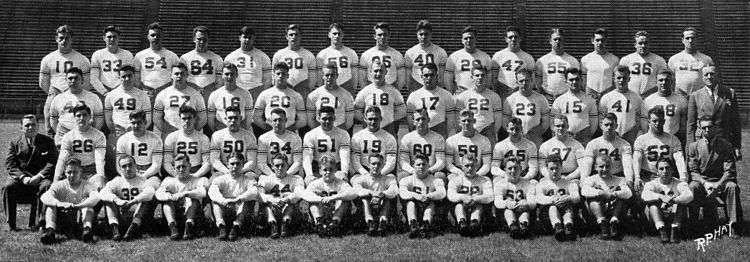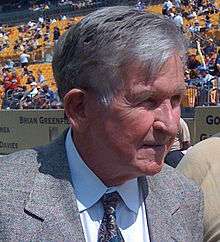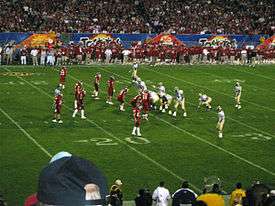Pittsburgh Panthers football
| Pittsburgh Panthers Football | |||
|---|---|---|---|
| |||
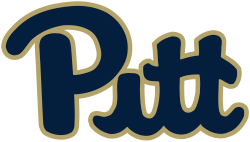 | |||
| First season | 1890[1] | ||
| Athletic director | Heather Lyke | ||
| Head coach |
Pat Narduzzi 4th season, 24–20 (.545) | ||
| Other staff |
Shawn Watson (OC) Randy Bates (DC) | ||
| Stadium |
Heinz Field (Capacity: 68,400) | ||
| Year built | 2001 | ||
| Field surface | Grass | ||
| Location | Pittsburgh | ||
| NCAA division | Division I FBS | ||
| Conference | ACC (since 2013) | ||
| Division | Coastal (2013–present) | ||
| Past conferences |
Big East (1991–2012) Independent (1890–1990) | ||
| All-time record | 717–527–42 (.574) | ||
| Bowl record | 13–20 (.394) | ||
| Claimed nat'l titles | 9 (1915, 1916, 1918, 1929, 1931, 1934, 1936, 1937, 1976) | ||
| Conference titles | 2 (2004, 2010) | ||
| Rivalries |
West Virginia (Backyard Brawl) Penn State (Keystone Classic) Notre Dame (rivalry) | ||
| Heisman winners | 1 (Tony Dorsett) | ||
| Consensus All-Americans | 51[2] | ||
| Colors |
Blue and Gold[3] | ||
| Fight song | Hail to Pitt and Pitt Victory Song | ||
| Mascot | Panther | ||
| Marching band | University of Pittsburgh Varsity Marching Band | ||
| Outfitter | Nike | ||
| Website | pittsburghpanthers.com | ||
The Pittsburgh Panthers football program is the intercollegiate football team of the University of Pittsburgh, often referred to as "Pitt", located in Pittsburgh, Pennsylvania. Traditionally the most popular sport at the university, Pitt football has played at the highest level of American college football competition, now termed the NCAA Division I Football Bowl Subdivision, since the beginning of the school's sponsorship of the sport in 1890. As of the 2013 season, Pitt competes as a member of the Atlantic Coast Conference (ACC).
Pitt has claimed nine national championships[4] and is among the top 20 college football programs in terms of all-time wins.[5] Its teams have featured many coaches and players notable throughout the history of college football, including, among all schools, the fifth most College Football Hall of Fame inductees,[6] the twelfth most consensus All-Americans,[7] and the third most Pro Football Hall of Fame inductees.[8] The Panthers are currently coached by Pat Narduzzi. Pitt plays home games at Heinz Field which they share with the National Football League Pittsburgh Steelers and utilize the University of Pittsburgh Medical Center Sports Performance Complex as their practice facility.
History
Early history (1889–1954)
.jpg)
Football at the University of Pittsburgh began in the fall of 1889 when the school was still known as the Western University of Pennsylvania, often referred to as WUP, and was located in what was then known as Allegheny City and is today the city of Pittsburgh's North Side. A 130-pound WUP student, Bert Smyers, along with senior student John Scott, assembled a football team that year composed of only three players who had previously witnessed the sport. The team played in one informal game, a loss against Shady Side Academy, in which Smyers made himself quarterback and Scott played center. In preparation for the following year, the first season of football officially recognized by the university, Smyers and his teammates took up a collection and purchased a football for practices and games; players were responsible for their own uniforms. In Smyers' case, his uniform was pieced together by his mother and sister.[9] The first official game for the university was played on October 11, 1890, when the Allegheny Athletic Association's opponent, Shadyside Academy, failed to appear for its game at Exposition Park. Allegheny A.A. called Smyers who brought the WUP team as a replacement. In an inglorious start to Pitt football history, WUP was defeated 38–0.[10] Smyers' team next faced Washington and Jefferson College, losing 32–0, but closed out its inaugural three game season with the university's first win, a 10–4 victory over Geneva College.[11] The following season saw the university collect more losses en route to a 2–5 record. Smyers suffered a broken nose in a 40–6 loss to Washington and Jefferson, a school that would become one of WUP's fiercest early rivals. The WUP team did record the school's first shutout with a 6–0 win over Geneva, as well as the school's first blowout in a 54–0 win over Western Pennsylvania Medical College who became affiliated with WUP in 1892 and later became the university's medical school when they merged in 1908.[11][12] Perhaps the most important development for the second season of football was Smyers recruitment of Joseph Trees from Normal University of Pennsylvania. The 210 pound Trees became WUP's first subsidized athlete[13] and, later in life, made millions in the oil industry and became an important benefactor for the university and athletic department. Today, Trees Hall, an athletic facility on the University of Pittsburgh's main campus in the Oakland section of Pittsburgh, bears his name. The first winning record for the university came in the third season of competition in 1892, when the team posted a 4–2 record. The following season in 1893, the team had its first official coach, Anson F. Harrold, who led the team to an unremarkable 1–4 record. However, during that season the first contest was played in what would become a 96-game series versus Penn State, thus originating one of the longest and fiercest rivalries for both schools. In 1895, the school suffered a 1–6 season under coach J.P. Linn. The 1895 season was notable for the first Backyard Brawl on October 26, 1895, with WUP losing to West Virginia 8–0 in Wheeling, West Virginia. The university did not see another winning season until Fred Robinson led WUP to a 5–2–1 record in 1898. In 1899, Robinson continued his success with a 3–1–1 record, giving the school its first back-to-back winning seasons. This was followed by two more consecutive winning seasons, including a record seven-win season in 1901 under coach Wilbur Hockensmith. That season, Hockensmith led the school to its first victory over West Virginia, a 12–0 shutout in Morgantown on October 5, 1901. The first winning record for the university came in the third season of competition in 1892, when the team posted a 4–2 record. The following season in 1893, the team had its first official coach, Anson F. Harrold, who led the team to an unremarkable 1–4 record. However, during that season the first contest was played in what would become a 96-game series versus Penn State, thus originating one of the longest and fiercest rivalries for both schools. In 1895, the school suffered a 1–6 season under coach J.P. Linn. The 1895 season was notable for the first Backyard Brawl on October 26, 1895, with WUP losing to West Virginia 8–0 in Wheeling, West Virginia. The university did not see another winning season until Fred Robinson led WUP to a 5–2–1 record in 1898. In 1899, Robinson continued his success with a 3–1–1 record, giving the school its first back-to-back winning seasons. This was followed by two more consecutive winning seasons, including a record seven-win season in 1901 under coach Wilbur Hockensmith. That season, Hockensmith led the school to its first victory over West Virginia, a 12–0 shutout in Morgantown on October 5, 1901.

In the early years of the 20th century, interest in college football grew both in Pittsburgh and throughout the nation. In 1903, Arthur St. Leger "Texas" Mosse was hired away from the University of Kansas, and brought several of his players with him. Other players were recruited from surrounding Western Pennsylvania colleges, including star half back Joseph H. Thompson.[14] The 1903 season, the first under Mosse, was the university's first winless season at 0–9–1.[n 1] In perhaps one of the greatest turnarounds in college football history, Mosse led WUP to an undefeated 10–0 season, the school's first, in 1904. The 1904 team surrendered only one touchdown on the way to collectively outscoring opponents 406–5.[17] That season also saw the school's first victory over Penn State, a 22–5 rout, as well as a 53–0 shutout of West Virginia.[n 2] The success of this period can be partially attributed to actions taken by the university's administration, led by newly installed chancellor Samuel McCormick who took special interest in athletics at the university. Encouraged by university trustee George Hubberd Clapp, the administration more actively engaged in supporting the athletic program during this period in order to promote the university. A football association was formed, the school's first booster organization, whose largest initial contributor was Andrew W. Mellon. The university also obtained a lease of Exposition Park to give the football team a more stable and permanent home, and its first full season at the park began with the 1904 undefeated team. This undefeated 1904 season was followed by a 10–2 record under Mosse in 1905, as well as six additional winning seasons.[21]
These Mosse coached squads featured team captain Joe Thompson, who was recruited from Geneva College to play for WUP from 1904 to 1906.[22] During Thompson's playing years, the team compiled a 26–6 record. Thompson graduated from the university in 1905 and continued on with post-graduate work in the School of Law completing his law degree. However, Thompson had long desired the head coaching position and finally obtained the job in 1909, after successful coach John A. Moorehead, who helped facilitate the first known use of numbers on the uniforms of football players in 1908,[23][24][25][n 3] left coaching to pursue his family's business interests. That same year, the university changed its name from Western University of Pennsylvania to the University of Pittsburgh, and it soon became known as "Pitt" among fans and students. The following year, in 1909, the school officially adopted the Panther as a mascot. Also in 1909, the school moved to the Oakland section of Pittsburgh where it remains to this day, and the football team began playing games at Forbes Field, starting with the third game of the season against Bucknell on October 16, 1909.[27]

Thompson coached at Pitt until 1912, the longest tenure of any coach to that point, and led the football team to a 22–11–2 record. The highlight of his coaching tenure was the 1910 season in which Pitt, led by star fullback Tex Richards, went undefeated for the second time in school history. Of even greater significance, the 1910 team was unscored upon, collectively outscoring its 9 opponents 282–0, and is considered by many to be that season's national champion.[28] Following his coaching stint, Thompson went on to become a highly decorated hero of World War I. Winning continued under coach Joseph Duff, including an 8–1 record in 1914 in which opponents were collectively outscored 207–38, and the university was well on the way to establishing itself as a regional, if not yet national, power. Duff would leave the Panthers after two seasons to serve in World War I, where he would be killed in combat in October 1918.

In 1914, Pitt athletic booster Joseph Trees and athletic director A. R. Hamilton hired Glenn Scobey "Pop" Warner as Pitt's head coach. Warner, who had previously led Carlisle, Cornell, and Georgia, had been successful at his previous stops, mentoring the likes of Jim Thorpe, and was known as an innovator of the game who originated the screen pass, single- and double-wing formations, and use of shoulder and thigh pads. His arrival at Pitt gave the program instant national credibility, lifting the perception of the program from a regional power to that of a national one.[29] Warner's impact was immediate. Led by center Robert Peck, Pitt's first First Team All-American, and All-American end James Pat Herron, Warner's first Pitt team in 1915 went 8–0, shutting out five opponents, and was trumpeted by football historian Parke H. Davis as that season's national champion.[30] His second season duplicated that success, repeating an 8–0 record while collectively outscoring opponents 255–25, and garnering what is widely regarded as a consensus national championship.[31] The lone scare of the 1916 season occurred at Navy when, following a delay of the team's train heading to Annapolis that caused a late arrival, the team overcame several fumbles and eked out a 20–19 victory.[32] The 1916 team was led again by Herron and Peck, now in his last season, as well as All-Americans fullback Andy Hastings and guard "Tiny" Thornhill. Also on that team were Jock Sutherland and H.C. "Doc" Carlson, who both would garner First Team All-American selections while members of the undefeated 1917 team, and go on to become perhaps Pitt's most legendary coaches in football and basketball, respectively. The 1917 team, nicknamed "The Fighting Dentists" because over half the roster became doctors or dentists, finished 10–0 with five shutouts despite losing several players to military service at the outbreak of World War I. The Spanish flu pandemic of 1918, which took the life of former Pitt star Tex Richards,[33] saw the implementation of quarantines that eliminated much of that year's college football season, including five of Pitt's originally scheduled contests. All of Pitt's games that year were played in November, including a high-profile game played as a War Charities benefit against undefeated, unscored upon, and defending national champion Georgia Tech, coached by the legendary John Heisman. Pitt swept through its first two games and then dismantled Georgia Tech 32–0 in front of many of the nation's top sports writers including Walter Camp. The final game of the season at Cleveland Naval Reserve resulted in Warner's first loss at Pitt and is one of the most controversial in school history. Warner, along with some reporters covering the game, insisted Pitt was robbed by the officials who, claiming the official timekeeper's watch was broken, arbitrarily ended the first half before Pitt was able to score and then allowed the Reserves extra time in the fourth quarter to pull ahead 10–9 before calling an end to the game.[34][35] Despite the loss, the 4–1 Panthers of 1918 were named by multiple selectors as a national champion for that season.[36]
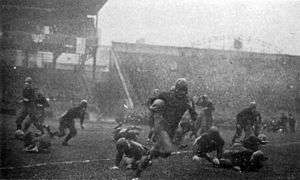
In 1919, several players suffered season-ending injuries, and Pitt stumbled to a 6–2–1 record that included another victory over Georgia Tech. The Panthers returned to undefeated status during 1920, albeit with ties against Syracuse and undefeated Penn State. The Penn State game ended in a scoreless tie after Pitt star Tom Davies, who was injured early in the game, returned later to miss a possible game-winning field goal. For the 1921 season, the team's record dipped to 5–3–1, but Pitt made college football history on October 8, 1921. Harold W. Arlin announced the first live radio broadcast of a college football game in the United States from Forbes Field on KDKA radio as the Pitt Panthers defeated West Virginia 21–13 in the annual Backyard Brawl.[37]
Prior to the 1922 season, Warner announced he was leaving Pitt to take the head coaching position at Stanford, but he honored his contract and remained at Pitt through 1923. 1922 resulted in an 8–2 record, and the season ended on a high note when the Panthers took their first cross-country trip, by train, to defeat Stanford, coached by two Pitt assistants sent ahead by Warner, 16–7 at Stanford. Jack Sack was named Walter Camp All-America honorable mention and New York Times All-East honorable mention, and was later named by football historian Dr. L.H. Baker to Pittsburgh's All-Time Team.[38] Warner's final season was his worst at Pitt as the Panthers stumbled to a 5–4 record in 1923. However, the Warner era at Pitt closed on a high note with a 20–3 victory over Penn State on November 29. In all, Warner coached his Pitt teams to 33 straight wins and three national championships (1915, 1916 and 1918).[39] He coached Pittsburgh from 1915 to 1923 to a combined 60–12–4 record.[40] Importantly, Warner helped raise the interest in Pitt football to the point where the university sought to build an on-campus stadium with increased seating capacity that would be dedicated to the football team, and the school began taking steps to secure the necessary land and funds to build Pitt Stadium.
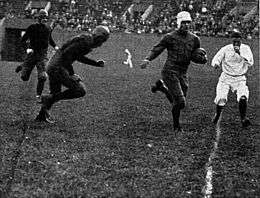
A natural replacement for Warner was Dr. John Bain "Jock" Sutherland, Warner's former All-American guard on the 1915 and 1916 national championship teams and 1917 undefeated team. A native of Coupar Angus in Scotland, Sutherland had graduated from the University of Pittsburgh's School of Dentistry, where he later served as faculty. Sutherland had served a tour in the Army and later achieved success as the head coach of Lafayette College from 1919 to 1923, leading the Leopards to the 1921 Eastern Collegiate Championship and shutting out Warner's Pitt teams in 1921 and 1922. So it was in 1924 that Sutherland returned to his alma mater to assume the head coaching duties with the goal of constructing dominant teams built on power and speed.[41] After a 5–3–1 record in his first season, Sutherland's second season kicked off the Panthers' first in the newly constructed Pitt Stadium and saw the team achieve an 8–1 record and win the 1925 Eastern Championship. The following year, the Panthers featured Gibby Welch, who led the nation in rushing in 1926 and helped Pitt to the Eastern Championship and its first bowl game, the Rose Bowl, in 1927. Pitt, ironically, lost the Rose Bowl 7–6 to a Stanford team headed by the Panthers' former coach, "Pop" Warner. In 1929, Pitt went undefeated in the regular season, the first of four undefeated regular seasons under Sutherland, and won the Eastern Championship, but lost its second appearance in the Rose Bowl to USC. Bowls at the time were still considered by many to be exhibition games, and the loss did not prevent football historian Parke Davis from naming Pitt as that season's national champion.[30]

The 1930 season, at 6–2–1, was a rebuilding one for Sutherland, and was marked by a loss to Notre Dame that would be the only meeting between Sutherland and Knute Rockne due to his death in a 1931 plane crash. The Irish also spoiled Pitt's perfect season in a 1931 game at South Bend, although the Panthers finished 8–1 with six shutouts, including a 40–0 dismantling of Nebraska. That season also saw Pitt defeat Penn State in State College, using only one first-string player, by a score of 41–6 en route to winning the Eastern Championship.[42] These accomplishments would prompt Parke Davis to again name the Panthers national champions.[30] Pitt would exact revenge at home the following season by shutting out Notre Dame 12–0, and would also upend undefeated Penn in Philadelphia, as well as shut out Stanford at home on their way to the 1932 Eastern Championship. However, the season ended when the Panthers, in their third Rose Bowl, were again defeated by USC. The 1933 season was spoiled only by a 7–3 loss at Minnesota in which the Panthers fumbled twice inside their own 5-yard line. Minnesota would best Pitt again in 1934, when the Panthers squandered a third quarter lead to lose 13–7 to the undefeated Gophers.[43] However, in 1934 Pitt also won at Nebraska 25–6, shut out Notre Dame 19–0, its third victory in a row over the Irish, and got revenge for the previous Rose Bowl losses to USC by defeating the Trojans 20–6 at Pitt Stadium. With these victories Pitt was named Eastern Champions as well as being awarded a share of the national championship by Parke Davis.[4][44][45] Pitt underwent rebuilding in 1935, going 7–1–2. Of historic note, in 1935, Pitt battled then football powerhouse Fordham, who featured the Seven Blocks of Granite which included guard Vince Lombardi, to the first of what would be three consecutive scoreless ties at New York City's Polo Grounds. Pitt ended the season with a 12–7 win at USC.
One of the greatest back-to-back stretches in Pitt football history occurred during the 1936 and 1937 seasons which featured Heisman Trophy candidate and Hall of Fame running back Marshall Goldberg. In 1936, Pitt shut out five of its opponents, including a 34–0 win over West Virginia, a 6–0 victory at Ohio State, and a 26–0 win over Notre Dame in which the Irish did not achieve a first down until late in the third quarter. The Panthers also won at Nebraska 19–6 and defeated Penn State 24–7. Only the second of three consecutive scoreless ties at the Polo Grounds against Fordham, and a mid-October 7–0 upset loss against crosstown rival Duquesne, marred the record. The Panthers finished the regular season winning the Lambert-Meadowlands Trophy as Eastern Champions and ranked third in the Associate Press Poll, the inaugural year of the poll, whose rankings were finalized before the bowl season. Pitt accepted a bid to the Rose Bowl to face Washington, and this time Sutherland was determined not to lose again out west. To avoid subpar play following the cross country train trip, Sutherland took his team out two weeks early to allow for adequate preparation. These moves paid off with a 21–0 rout of Washington which led many selectors to name Pitt as the 1936 national champions.[46] However, it was during this time that the seeds of a rift between Sutherland and the university's administration were being sown, partly initiated by the refusal of the university to supply pocket money for players during the Rose Bowl trip, which Sutherland then decided to supply out of his own pocket.[47] Pitt followed up the Rose Bowl winning 1936 season with a 9–0–1 record in 1937 that included five shutouts, including those over West Virginia, Wisconsin, and at Duke as well as additional victories against Penn State, Nebraska, and at Notre Dame. The only blemish on the record was the third consecutive tie at Fordham, which resulted when an apparent winning touchdown by Pitt's Marshall Goldberg was called back on a holding penalty.[48] Pitt finished the 1937 regular season as repeat Eastern Champions and was ranked number one in the AP's final poll. Partly due to the developing rift with the university administration, and also due to the time and expense of the travel, Pitt became the first team to publicly decline a Rose Bowl invitation following a vote of the players.[49] Despite its decision to sit out the postseason, the 1937 Pitt team was widely regarded as consensus national champions.[50]
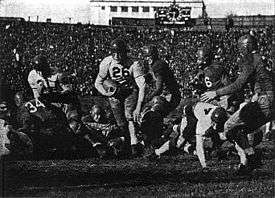
During this period, Pitt regularly dominated opposing teams, even inducing Notre Dame to drop Pitt from its schedule.[51] However, it was also during this era that the university, led by chancellor John Gabbert Bowman, began introducing policies designed to de-emphasize the athletic programs. This was manifested when a plan was instituted in the spring of 1937 by Athletic Director James "Whitey" Hagan, who had actually played for Sutherland, to eliminate university subsidies for athletes.[52] Hagan's plan was then absorbed into a 1938 athletics code of conduct, referred to as "Code Bowman", which discouraged alumni help, restricted practices to two hours a day, and eliminated both athletic recruiting and all direct subsidization of athletics.[53][54] While the implementation of these policies was the beginning of the end for that era of Pitt football prominence, the Panthers still impressed during the 1938 season behind an assembly of talent at running back labeled the "Dream Backfield." With Goldberg at fullback, Dick Cassiano and Harold Stebbins at halfback, and John Chickerneo at quarterback, Pitt won at Wisconsin, shut out West Virginia and Penn State at home and Nebraska on the road, and routed Southern Methodist. Notably, the deadlock against Fordham was finally broken as Pitt defeated the Rams 24–13 at Pitt Stadium.[55] However, Pitt was tripped up against neighboring rival Carnegie Tech and at undefeated Duke. Following the season, the split between the administration and Sutherland became complete, and Sutherland resigned in March saying "The present system of athletic administration has resulted in conditions which, for me, are intolerable." The resignation caused a firestorm in the press and among the program's supporters, and resulted in student outrage and protests. However, the athletic code was firmly implemented and Sutherland's resignation stood.[56][57]
Sutherland, who was described as "a national hero" in a Saturday Evening Post article,[58] was perhaps the most highly admired and influential coach in the history of the university. Following his years at Pitt he never coached again in college and moved on to a career in the NFL including a head coaching stint with the Pittsburgh Steelers before his untimely death in 1948 of a brain tumor. During his 15-year tenure at the university, the longest of any football coach at Pitt, he compiled a record of 111–20–12 which included 79 shutouts. Sutherland never lost to rival Penn State and lost only once to West Virginia, and his teams were named Eastern football champions seven times: 1925, 1927, 1929, 1931, 1934, 1936, and 1937.[59] During this time, Pitt appeared in four Rose Bowl games (1928, 1930, 1933, and 1937) and turned down a bid for the 1938 Rose Bowl.[60] Sutherland's teams were named "National Champions" by various selectors for nine different seasons including 1925, 1927, 1929, 1931, 1933, 1934, 1936, 1937, and 1938.[30][61] Of these, the University of Pittsburgh officially recognizes five of those years as national championship seasons: 1929, 1931, 1934, 1936, and 1937.[61]

The policy of deemphasis resulted in a dramatic downturn for Pitt's football fortunes, including a succession of coaches with short stints. Charley Bowser, a former player at Pitt under "Pop" Warner, took over in 1939, but the lack of athletic subsidies had eroded the talent base and the on-field results likewise steadily deteriorated. Bowser started 3–0 in 1939 and Pitt was ranked number one in the AP poll, but won only two more games and finished 5–4. Eight consecutive losing seasons followed. Pitt's stars during this period were running back Edgar "Special Delivery" Jones and guard Ralph Fife, who led Pitt to an upset win over undefeated Fordham in 1941.
Bowser was replaced by Clark Shaughnessy in 1943; and in 1945, with new university chancellor Rufus Fitzgerald at the helm, athletic scholarships and recruiting were reinstated. However, substantial damage had already been done to the football program. Shaughnessy was replaced in 1946 by Wes Fesler, who left after his only season at Pitt to coach his alma mater Ohio State. Walter "Mike" Milligan took over head coaching duties in 1947 and scored one of the most satisfying wins in Pitt history when the Panthers defeated the Fesler-coached Ohio State team 12–0 for their only win of the season. During this era Pitt's first African-American player, Jimmy Joe Robinson, led the team in receiving and rushing, and also excelled at returning punts and kickoffs. Milligan brought Pitt back to winning records in 1948 and 1949, achieving consecutive 6–3 seasons that included appearances in the national rankings and back-to-back shutouts of Penn State. However, Milligan resigned after the 1949 season, never to return to head coaching, due to a perceived snub by the university offering him only a one-year contract.[62] During this same period, Pitt sought entry into the Big Ten Conference as the replacement for the University of Chicago, which had withdrawn from the conference. Pitt had placed its athletic programs under the Big Ten's supervision in 1939, which newspapers of the time characterized as a probationary admission likely to result in eventual full membership.[63] Pitt's application for membership was never approved, partly due to opposition by Ohio State, out of their concern that conference membership for Pittsburgh would diminish a possible recruiting advantage such membership gave to the Buckeyes in talent-rich Pennsylvania. Instead, Michigan State, rather than Pitt, was eventually selected for Big Ten membership in May 1949.[64]
Len Casanova took the Pitt job in 1950 but a disastrous campaign was followed by his departure following spring practice in 1951. This led to athletic director Tom Hamilton taking the reins of the team on an interim basis for the 1951 season. In 1952 Red Dawson took over, and the Panthers, led by future Hall of Famer Joe Schmidt, scored a huge upset at Notre Dame, then coached by Frank Leahy, en route to a 6–3 record. However, a losing record followed in 1953, and after three losses to start the 1954 season, and due to poor health, Dawson stepped down. For the remainder of the season Hamilton again took over the team, guiding Pitt to an upset of number nine Navy and handing West Virginia its only loss of the season.[65]
John Michelosen era (1955–1965)
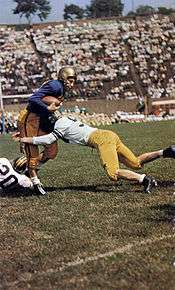
In 1955 Pitt sought a return to the roots of its previous success by turning to John Michelosen, a quarterback on Jock Sutherland's 1936 and 1937 championship teams who later served as a Sutherland assistant and as the head coach of the Pittsburgh Steelers. Michelosen immediately brought Pitt football back to respectability in his first season with the 1955 Eastern Championship that was capped by an appearance in the 1956 Sugar Bowl. Pitt's invitation to the Sugar Bowl was surrounded by controversy because Pitt, an integrated team, was the first to bring an African-American, Bobby Grier, to play in a southeastern bowl game in the segregated Deep South.[66] Grier's play in the Sugar Bowl cemented the university's place in civil rights history as the first team to break the color barrier for southeastern bowls. However, the game was marred by protests in the South leading up to the game, which Pitt lost 7–0 when a controversial interference penalty was called on Grier that set up the winning touchdown for Georgia Tech. The following season, Michelosen guided Pitt to another bowl berth, the Gator Bowl, which resulted in another seven-point loss to Georgia Tech.[66]
Four additional winning seasons followed against formidable national schedules that were highlighted by victories over Notre Dame, USC, Miami, UCLA, Penn State, Oregon, Syracuse, Nebraska, and West Virginia. A three win season in 1961 that included wins at Miami and over Navy and USC, along with three close losses by 6 points or less to Baylor, Washington, and Notre Dame, was followed by a 5–5 record in 1962 and then perhaps the best team of the Micheloson era in 1963. The 1963 team, led by All-American Paul Martha, swept through a schedule that included wins at Notre Dame, UCLA, West Virginia, and Miami and home victories against Washington, Cal, Syracuse, and Penn State. The only loss of the season was in late October at Navy, which was led by Roger Staubach and would finish the season ranked second in the nation. The Panthers, at 7–1 and ranked fourth in the nation, headed into their rivalry against Penn State with a chance to play for a national championship. However, national tragedy struck on November 22 when President John F. Kennedy was assassinated which resulted in postponing Pitt's next-to-last game against Penn State from November 23 to December 7. The Panthers defeated the Miami Hurricanes on November 30, improving their record to 8–1. The bowls, which feared inviting Pitt before their season finale against Penn State the following week, signed other teams, leaving Pitt without a bowl invitation despite defeating the Nittany Lions, 22–21, and ending the season with a 9–1 record. Perceived as perhaps the best team of the modern football era not to appear in a bowl, the 1963 team finished with its number three ranking intact, but infamously received the label of the "No Bowl Team".[67]
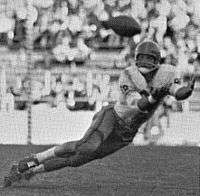
The bad luck of 1963 seemed to jinx the program for the rest of Michelosen tenure, and despite wins over Oklahoma, Miami, West Virginia, and Penn State, two three-win seasons followed. The losses prompted the removal of Michelosen as coach, a move that sent the football program into a tailspin.
In eleven seasons at Pitt, the second longest coaching tenure at the school after Sutherland's, Michelosen achieved a 56–49–7 record with only 4 losing campaigns. Pitt finished ranked among the top twenty programs in four seasons with Michelosen at the helm. Michelosen was a major coaching influence on such modern day NFL coaching greats as Mike Ditka and Marty Schottenheimer, both of whom played at Pitt under Michelosen.
Hart and DePasqua (1966–1972)
The years that followed Michelosen's tenure were among the most downtrodden years of Pitt football as the Panthers compiled a sickly 16–56 record over the next six seasons. David Hart, who replaced Michelosen, produced three straight one-win seasons where many games produced embarrassing scores (the average score during Hart's three years was 34–9). Hart was replaced in 1969 by Carl DePasqua, who had previously won a Division II national title as Waynesburg's coach and had been currently serving as an assistant coach for the Pittsburgh Steelers. DePasqua brought a handful of wins, including upsets over Syracuse, West Virginia, and at UCLA and produced the Panthers' first non-losing season in seven years, but could not achieve a winning record and was relieved following a disastrous single win campaign in 1972.
Johnny Majors era (1973–1976)

University Chancellor Wesley Posvar took action to revive the football program and hired Johnny Majors from Iowa State to resurrect the program in 1973. Majors immediately upgraded the recruiting, most notably bringing in future Heisman Trophy winner Tony Dorsett. Majors' impact was immediate: in Pitt's first game with Majors as coach, the Panthers travelled to the University of Georgia where they tied Vince Dooley's Bulldogs 7–7. The excitement in the city was palpable as the Panthers improved from one win in 1972 to a 6–5–1 record in 1973. Their success earned the Panthers their first bowl bid since 1956 when they were invited to play Arizona State in the 1973 Fiesta Bowl, where they lost 28–7. The next season saw further improvement with wins at Florida State and Georgia Tech to finish 7–4. In 1975, a Sun Bowl victory over Kansas capped an 8–4 record highlighted by wins at Georgia and Notre Dame. The stage was thus set for the 1976 edition of the Panthers to make a run for the national championship.
The 1976 season began with the Panthers ranked ninth in the AP preseason poll. The first game was at Notre Dame, where the Irish grew the grass long on the playing field in a failed attempt to slow down Dorsett, who had burned them for 303 rushing yards the year before.[68] Their efforts were in vain as Dorsett ran for a 61-yard touchdown on Pitt's first play from scrimmage on the way to a 31–10 win. The season continued with a 42–14 win at Georgia Tech and a 36–19 win over Miami. On October 23, the Panthers travelled to Annapolis to face Navy during which Dorsett broke the NCAA career rushing record on a 32-yard touchdown run in Pitt's 45–0 victory. Dorsett's achievement prompted a mid-game celebration in which even Navy saluted the feat with a cannon blast.[69] Pitt next defeated eastern rival Syracuse 23–13, and on November 6, number two ranked Pitt easily handled Army while number one ranked Michigan lost to Purdue. For the first time since 1939, the Pitt Panthers were the number one ranked team in the country. The following week, they successfully defended their top rating in a close Backyard Brawl against rival West Virginia. With a record of 10–0, the Panthers headed into their regular season finale with only heated instate rival Penn State standing in the way of Pitt's national title aspirations. At a packed Three Rivers Stadium on the day after Thanksgiving, the Nittany Lions held Dorsett to 51 yards in the first half and had the game tied 7–7. Majors adjusted for the second half by shifting Dorsett from tailback to fullback, enabling him to explode for an additional 173 yards as Pitt rolled to a 24–7 victory that capped an undefeated regular season.[70] In December, Dorsett became the first Pitt Panther to win the Heisman Trophy as the nation's best college football player. Dorsett also won the Maxwell Award, the Walter Camp Player of the Year Award, and was named UPI Player of the Year. The 11–0 Panthers accepted an invitation to the 1977 Sugar Bowl to face second ranked Georgia. Pitt defeated the Bulldogs 27–3 and was voted number one in both the final Associated Press and Coaches polls, claiming their ninth national championship.[71] This was Pitt's first undefeated national championship since 1937. The American Football Coaches Association (AFCA) named Majors the 1976 Coach of the Year. Following this historic season, Majors returned to his alma mater, the University of Tennessee, to take the head coaching job.[72]
Jackie Sherrill era (1977–1981)
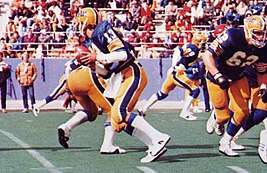
Jackie Sherrill, an assistant under Majors at Iowa State and Pitt and the head coach at Washington State, succeeded Majors as head coach at Pitt. Under Sherrill, the winning continued with a 9–2–1 record and Gator Bowl win in 1977. An 8–4 record and Tangerine Bowl appearance followed in 1978. Sherrill stockpiled future NFL talent including Pittsburgh's own quarterback Dan Marino, Hall of Fame inductee Russ Grimm, and Outland Trophy winner Mark May. Sherrill also molded a devastating defense that was anchored at the defensive end position manned by Hall of Fame inductee Rickey Jackson and Heisman Trophy runner-up Hugh Green, who had the highest finish in the Heisman voting by a defensive player until 1997, when Michigan's cornerback Charles Woodson, who also played receiver, won the trophy. 1979 began a string of three straight seasons with 11–1 records. However, an early loss at North Carolina in 1979, a midseason loss during a driving rainstorm at Florida State in 1980, and a devastating season-ending defeat at the hands of rival Penn State in 1981 prevented those teams from clinching an AP or Coaches poll national championship. The 1981 loss to Penn State at Pitt Stadium was especially devastating, as the number one ranked Panthers had opened up a 14–0 first-quarter lead only to see an apparent Dan Marino touchdown pass intercepted in the endzone. The Nittany Lions scored 48 unanswered points to end the Panthers' dream of a second national championship in five years.[73] In each of these three seasons, Pitt rebounded to win a bowl game: the Fiesta, Gator, and Sugar Bowls respectively. The 1982 Sugar Bowl was highlighted by one of the most dramatic plays in Pitt history as Dan Marino hit a streaking John Brown on fourth down in the last seconds of the game for the go-ahead score against a Georgia team that featured Herschel Walker.[74] Sherrill's teams at Pitt are considered by some to be among the most talented in Pitt and college football history. The 1980 Pitt team alone featured seven first round draft picks, 23 players who went on to start in the NFL, seven others who played in the NFL, and one player each who played in the CFL and the USFL.[75] Bobby Bowden, legendary coach of Florida State, is quoted as saying, "I've said it many times, in all my years of coaching, that Pitt team was the best college football team I have ever seen."[76] Sherrill left Pitt in early 1982 for Texas A&M, signing a then record contract worth over $1.7 million.[77] In five seasons, Sherrill's Panthers won fifty games, lost nine, and tied one (50–9–1), which places his 0.842 winning percentage at the top of the list for all Pitt coaches, just ahead of Jock Sutherland.
Foge Fazio era (1982–1985)
Defensive coordinator and Pitt alumnus Foge Fazio took the reins of the preseason number one team for 1982. Expectations were high—dreams of a national championship seemed realistic.[78] The loaded Panthers, in Marino's senior season, stormed out to a 7–0 record and number one ranking before losing to Notre Dame at Pitt Stadium. A season-ending loss at Penn State and a 1983 Cotton Bowl Classic loss to Southern Methodist left Pitt fans disappointed. National championship aspirations again failed to materialize in 1983 when Pitt fell to 8–3–1, including a loss to Ohio State in the 1984 Fiesta Bowl, despite inspired play from All-American offensive tackle Bill Fralic. A disastrous three-win season in 1984 was somewhat redeemed by a season-ending demolition of Penn State. However, a five-win season in 1985 prompted the school to relieve Fazio of his duties.
Mike Gottfried era (1986–1989)
Mike Gottfried, who was previously Kansas' head football coach, recruited well, defeated rival Penn State twice, and led Pitt to the 1987 Astro-Bluebonnet Bowl and the 1989 John Hancock Bowl. Late in his tenure, the university's administration increased admissions standards for student-athletes to a level above those of its peer institutions and the NCAA. Gottfried fought these policy changes, which caused him to fall out of favor with the school's administration, including Chancellor Wesley Posvar. Additionally, Gottfried had poor relations with boosters, alumni and the media. As a result, Gottfried was fired after the 1989 season despite a 27–16–2 overall record.[79][80]
Paul Hackett era (1990–1992)
Gottfried was replaced by his offensive coordinator, Paul Hackett, just prior to the 1989 John Hancock Bowl in which Pitt defeated Texas A&M. Under Hackett, the Panthers went 3–7–1 in 1990, improved to 6–5 in 1991 but fell to 3–8 in 1992, leading to his dismissal as head coach. Assistant coach and Pitt alumnus Sal Sunseri took over as interim head coach for the final contest at Hawai'i. With new academic policies in place, the football program underwent a steep decline. Hackett only posted one winning season. Hackett's overall record at Pitt is 13–20–1.
In 1991 Pitt joined the new Big East Football Conference, thus ending its history as a football independent. Pitt had been a member of the Big East in most other sports, including basketball, since 1982.
Johnny Majors returns (1993–1996)
The university again looked to its past to reverse its fortunes and brought back Johnny Majors, who had recently resigned from Tennessee after a successful 16-year tenure there. However, recruiting had fallen off significantly under Hackett, and the quality of Pitt's football facilities had fallen behind those of its competition. Over the next four years, Majors tried to recreate the magic of the 1976 season but achieved little success. His final campaign in 1996 resulted in a 4–7 record which included several humiliating defeats. A new chancellor, Mark Nordenberg, brought in athletic director Steve Pederson in 1996 to resurrect the program.[81] The move facilitated Majors' retirement from coaching following the 1996 season, although he continued to serve the university in the position of Special Assistant to the Athletic Director and Chancellor until the summer of 2007.[82]
Walt Harris era (1997–2004)

The Pitt football program saw many changes instituted in 1997. New athletic director Steve Pederson moved to revamp the athletic department after the preceding years had wounded the program's image.[83] A controversial emphasis on the use of the full name "Pittsburgh", at the expense of the university's abbreviated moniker "Pitt", along with new logos designed to invoke the heritage of the steel industry in the region, were instituted in an attempt to tie the school more closely to the image of the city. New shades of blue and gold were introduced and the athletic booster club was overhauled.[84] Walt Harris, who had built a reputation as a quarterback guru with a background in the West Coast Offense, was brought in to replace Majors in 1997 and undertook the task of rebuilding a program that won only fifteen games in the previous five seasons. Results were almost immediate as Harris took Pitt to the 1997 Liberty Bowl in his first season, finishing with a 6–6 record. Over the next two seasons, the Panthers posted a losing record as Harris worked on enhancing the talent in Pitt's program. At the same time, the university administration decided to bring the football program's deteriorating facilities in line with those of Pitt's peers. A state-of-the art practice facility, the UPMC Sports Performance Complex, was constructed on the city's South Side in collaboration with the University of Pittsburgh Medical Center. In lieu of much-needed but cost-prohibitive renovations to modernize Pitt Stadium, the administration made a controversial decision to move home games to the newly proposed North Shore stadium, later named Heinz Field, and to demolish Pitt Stadium in order to build a long-awaited convocation center on its footprint.[85] 1999 was the final season for the Panthers in Pitt Stadium, which had served Pitt for 75 seasons. On November 13, 1999, the Panthers upset Notre Dame 37–27 in the last game played at the stadium. Although the Panthers showed improvement during the 1999 season, their loss in the season finale at West Virginia left them with a 5–6 record and without a bowl.

Pitt played its home games in 2000 at Three Rivers Stadium. Behind an increasing number of talented players, led by Biletnikoff Award winner Antonio Bryant, Pitt was back to a winning record in 2000 and played Iowa State in the 2000 Insight.com Bowl. In the second game of the 2000 season, Pitt defeated rival Penn State 12–0 which was the last game played between these two teams for 16 years.[86] In 2001, Pitt began playing its home games at Heinz Field. Additional bowl games and national rankings followed over the next four seasons. Overall Harris led the Panthers to a bowl game in six of his eight seasons, including five consecutive bowl games from 2000 through 2004, with bowl victories in the 2001 Tangerine Bowl over North Carolina State in 2001 and, led by Biletnikoff and Walter Camp Award winner Larry Fitzgerald, over Oregon State in the 2002 Insight Bowl. Harris also led Pittsburgh to a share of the Big East Conference championship in 2004 and Pitt received the conference's automatic Bowl Championship Series (BCS) bowl bid, playing Utah in the 2005 Fiesta Bowl. Harris was named the Big East Conference Coach of the Year in 1997 and 2004, and he was the AFCA Region I Coach of the Year in 2002. Over his eight years at Pitt, from 1997–2004, Harris compiled an overall record of 52–44. However, alumni and fans were growing restless with perceived recruiting deficiencies and an inability to return the program to the highest level. When disparaging remarks about the program were made by his agent, Harris' contract negotiations with the school stalled. This led to an announcement prior to the Fiesta Bowl in 2004 that Harris was leaving Pitt to become head coach at Stanford.[87]
Dave Wannstedt era (2005–2010)

Dave Wannstedt, a Pittsburgh area native and former Pitt player, graduate, and graduate assistant coach (1975–78), who had recently resigned as head coach of the NFL's Miami Dolphins, succeeded Harris as Pitt's head coach on December 23, 2004. Wannstedt's return to his alma mater was marked by a return to the use of the wordmark "Pitt" as a logo, including its display on the football helmets.[88]
Known for his prowess in college recruiting when an assistant to Jimmy Johnson, Wannstedt reeled in classes that were nationally ranked throughout his tenure at Pitt.[89][90] However, little improvement was seen at first in the record column as Pitt struggled with a 5–6 and 6–6 record in his first two seasons. The 2007 season featured several close losses, but the team showed signs of improvement on the way to a 4–6 record prior to the last game of the season at number two ranked West Virginia. The game in Morgantown on December 1, 2007, was the 100th Backyard Brawl, and would prove to be one of the greatest of the series. The four touchdown favorite Mountaineers needed only a win over archrival Pitt to earn a spot in the BCS National Championship Game. However, Wannstedt earned his signature victory and marked a turning point for the program with perhaps the biggest upset in both schools' histories when Pitt defeated West Virginia 13–9 and thus prevented the Mountaineers from playing for the national championship.[91]

The following season, Pitt recorded key victories against Iowa, tenth ranked South Florida, West Virginia, and a 36–33 four-overtime thriller at Notre Dame, the longest game ever for both Notre Dame and Pittsburgh. A close defeat in the River City Rivalry against Cincinnati cost Pitt a conference championship, but the Panthers played in the Sun Bowl, its first bowl bid under Wannstedt, and finished with a 9–3 record. In 2009, Pitt shot off to a 9–1 start, its best start since 1982, with impressive wins over Navy, Notre Dame, and Rutgers, and had climbed to ninth in the AP and BCS polls. However, Pitt lost its final two regular season games, including a last second loss by a field goal at West Virginia and a one-point loss at home for the Big East championship to undefeated Cincinnati. The Panthers rebounded by winning the Meineke Car Care Bowl over North Carolina, 19–17, to finish ranked 15th and achieve its first ten-win season since 1981. In addition, Pitt players garnered many post-season accolades, including Big East Offensive Player and Rookie of the Year in Dion Lewis, and Big East Co-Defensive Players of the Year in Mick Williams and Greg Romeus.
Prior to the 2010 season, Pitt was selected as the preseason favorite to win the Big East and was ranked fifteenth in the preseason polls. However, Pitt stumbled out of the gate with an overtime loss at Utah and dropped out of the polls for the remainder of the season. Although they claimed a share of the Big East championship (along with Connecticut and West Virginia), Pitt ended the regular season with a disappointing 7–5 record and an invitation to the BBVA Compass Bowl. This prompted Dave Wannstedt's resignation as head coach on December 7, 2010,[92] with defensive coordinator Phil Bennett taking over for the bowl game.
Mike Haywood controversy
On December 16, 2010, Miami (OH) head coach Mike Haywood was introduced as Wannstedt's replacement as head coach.[93] At his introductory press conference, athletic director Steve Pederson said Haywood was "a man of integrity and character and will be a true inspirational leader for our football team."[93] However, Haywood's arrest on domestic violence charges in South Bend, Indiana on December 31, two weeks and two days later, prompted Pitt to fire him immediately.[94] Haywood never coached a game, recruited a player, led a practice or even hired an assistant coach at Pitt. His sixteen-day tenure at Pitt is the second shortest in FBS history (only to George O'Leary's five-day tenure at Notre Dame).[95] Despite the turmoil, Bennett led the Panthers to a 27–10 bowl victory over Kentucky on January 8, 2011.[96]
Todd Graham era (2011)
Following the bowl win, Pitt announced Tulsa head coach Todd Graham as the new head coach of the Panthers.[97] At his introductory press conference, Graham talked about how Pitt was a "dream come true" and that he would work hard every day to "gain everyone's trust" and that he would coach his players to do the same.[98] Graham instituted a sweeping change of offensive and defensive philosophies[99] but staggered to a 6–6 regular season. However, major news for the university was announced in September of that season when Pitt accepted an invitation to join the Atlantic Coast Conference effective July 1, 2013.[100] On December 14, 2011, less than one year after being hired, Graham shocked Pitt when he resigned to take the head coaching position at Arizona State.[101] Defensive coordinator Keith Patterson was named as the interim head coach for the BBVA Compass Bowl,[102] which the Panthers lost to Southern Methodist by a score of 28–6.[103]
Paul Chryst era (2012–2014)
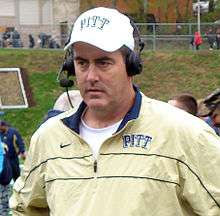
On December 22, 2011, Wisconsin offensive coordinator Paul Chryst was introduced as the head coach[104] and lead the Panthers in their final season of the Big East which included another appearance in the BBVA Compass Bowl and a 6–7 final record.[105] Chryst's hiring made him the Panthers' fourth head football coach since December 2010 (sixth counting interims).[104]
Chryst led Pitt into the Atlantic Coast Conference where the program competed in the conference's Coastal Division during the 2013 season. The Panthers again posted a 6–6 record in the 2013 regular season and accepted an invitation to the Little Caesars Pizza Bowl, where they defeated Bowling Green 30–27.[106] On December 17, 2014, Chryst was announced as the new head coach at Wisconsin; athletic director Steve Pederson was fired on the same day as Chryst's departure.[107] On December 17, 2014 Joe Rudolph was named interim coach for the Armed Forces Bowl against the University of Houston.[108]
Pat Narduzzi era (2015–present)
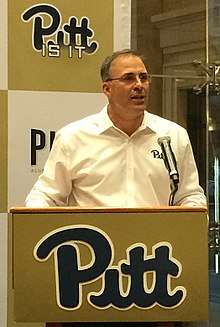
On December 26, 2014; Michigan State defensive coordinator Pat Narduzzi was named the 37th Pitt head coach.[109] Although he didn't have any head coaching experience, Narduzzi was regarded as one of the country's best defensive minds and assistant coaches who had recruiting strong ties to the northern United States and, specifically, east Ohio and west Pennsylvania.[110] Pittsburgh signed Narduzzi to a five-year contract.[111]
Pitt went 8–5 in 2015.[112] The Panthers began the Narduzzi era on September 5 with a 45-37 victory over FCS opponent Youngstown State.[113] Pittsburgh won their second game of the season the following week, defeating Akron by a score of 24-7.[114] After a 27-24 loss to Iowa,[115] Narduzzi's squad defeated Virginia Tech by a margin of 17-13.[116] In the season's fifth game, the Panthers defeated Virginia by a score of 26-19.[117] A third straight win came on October 17 with a 31-28 victory over Georgia Tech.[118] After a 23-20 victory over Syracuse,[119] Pittsburgh suffered its second defeat of the season with a 26-19 loss to North Carolina.[120] On November 7, Narduzzi's Panthers lost to #8 Notre Dame by a score of 42-30.[121] That was followed by a 31-13 victory over Duke.[122] After a 45-34 victory over Louisville,[123] Pitt fell to Miami in the regular season finale by a score of 29-24.[124] The Panthers accepted an invitation to the Military Bowl, where they lost to #21 Navy by a margin of 44-28.[125] During the 2015 season, Pitt was ranked in the AP top 25 for the first time since 2010. Narduzzi's first full recruiting class, in 2016, was ranked 30th in the country, Pitt's highest ranked class since 2008.[126] On December 10, 2015; Pitt signed Narduzzi to a two-year contract extension and raised his pay.[127]
The Panthers finished with another 8–5 record in 2016.[128] In the season opener, they defeated in-state FCS opponent Villanova by a score of 28-7.[129] After a 42-39 victory over archrival Penn State,[130] Pittsburgh suffered their first loss of the season, dropping a 45-38 contest to Oklahoma State.[131] After a nailbiting 37-36 loss to North Carolina,[132] Narduzzi's team won a 43-27 contest over Marshall on October 1.[133] A second straight win followed one week later when the Panthers defeated Georgia Tech by a margin of 37-34.[134] Narduzzi's squad won a third straight game On October 15 when they defeated Virginia by a score of 45-31.[135] Pittsburgh then suffered consecutive defeats, falling to #25 Virginia Tech by a margin of 39-36[136] and Miami by a score of 51-28.[137] On November 12, the Panthers traveled to Clemson, South Carolina and knocked off #3 Clemson by a score of 43-42 on a late field goal.[138] Pitt followed that huge upset victory with a 56-14 blowout win over Duke[139] and a high-scoring 76-61 shootout victory over Syracuse to finish the regular season.[140] Pittsburgh accepted an invitation to the Pinstripe Bowl, a game they lost to Northwestern by a score of 31-24.[141]
Pittsburgh slipped to a 5–7 record in 2017.[142] The Panthers kicked off the season on September 2, defeating FCS Youngstown State in overtime by a score of 28-21.[143] One week later, Pitt lost the Keystone Classic to archrival #4 Penn State by a margin of 33-14.[144] In the season's third game, Narduzzi's squad lost its second straight contest with a 59-21 defeat at the hands of #9 Oklahoma State.[145] After a 42-10 victory over Rice,[146] the Panthers lost another two straight; falling to Syracuse by a margin of 27-24[147] and #20 NC State by a score of 35-17.[148] Pitt then won their next two; defeating Duke by a margin of 24-17[149] and Virginia by a score of 31-14.[150] After a 34-31 loss to North Carolina[151] and a 20-14 defeat to #17 Virginia Tech[152] knocked the Panthers out of bowl contention, Narduzzi's team finished the season with a big upset victory, stunning #2 Miami by a score of 24-14.[153] On December 6, 2017, the University of Pittsburgh administration signed Narduzzi to another contract extension and raise, extending his deal by seven years.[154]
Pittsburgh's 2018 record is currently 2-3 with their most recent loss at Central Florida where the opposing coach and some players accused the Pitt players of faking cramps.
National championships
Pitt claimed

The University of Pittsburgh claims nine National Championships: 1915, 1916, 1918, 1929, 1931, 1934, 1936, 1937, and 1976[4] out of a total of 12 seasons[n 4] that it has been selected as a national champion by a "major selector" as determined by the Official NCAA Records Book[156] and out of 16 seasons that it has been named the National Champion by at least one selector according to research by the College Football Data Warehouse.[30]
The university bases its claim for the first eight national championships on a study conducted in 1970 by Sports Illustrated.[4][44] These championships, together with its unanimous championship of 1976, are the basis for the university's claim of nine national championship seasons. Combining CFBDW research with the Official NCAA RecordsBook and Sports Illustrated study, Pitt has been recognized as the National Champion by at least one selector in 17 different seasons.[n 5]
Using the research compiled by Sports Illustrated, the nine national championships claimed by Pitt are presented in their annual football media guide as follows:[4]
| Year | Coach | Selector(s) | Record |
|---|---|---|---|
| 1915 | Glenn "Pop" Warner | Parke Davis | 8–0 |
| 1916 | Glenn "Pop" Warner | Unanimous | 8–0 |
| 1918 | Glenn "Pop" Warner | Unanimous | 4–1 |
| 1929 | Jock Sutherland | Parke Davis | 9–1 |
| 1931 | Jock Sutherland | Parke Davis | 8–1 |
| 1934 | Jock Sutherland | Parke Davis | 8–1 |
| 1936 | Jock Sutherland | The Football Thesaurus (Houlgate System), Illustrated Football Annual (Boand System) | 8–1–1 |
| 1937 | Jock Sutherland | AP, Dunkel System, Litkenhous, Williamson System, Illustrated Football Annual (Boand System), he Football Thesaurus (Houlgate System) | 9–0–1 |
| 1976 | Johnny Majors | Unanimous | 12–0 |
NCAA records book
see also: Year-by-year list of "Major" National Championship Selections
According to the Official NCAA Division 1 Football Records Book, Pitt has been named a national champion by a "Major Selector" in 11 separate seasons.[157] The seasons listed in the NCAA Records Book include:
1910 • 1915 • 1916 • 1918 • 1929 • 1931 • 1936 • 1937 • 1976 • 1980 • 1981
CFBDW
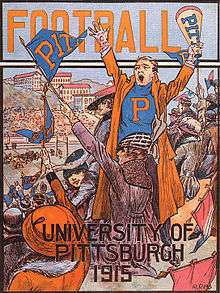
College Football Data Warehouse lists nine recognized national championship seasons in which the University of Pittsburgh was named a National Champion. CFBDW lists the Joe Thompson coached 1910 undefeated and unscored upon team as a recognized National Champion, whereas the university does not claim this championship. However, CFBDW does not list the 1934 season, claimed by Pitt, as a recognized championship season. The following nine seasons are the years Pitt is listed as a Recognized National Champion in College Football Data Warehouse:[158]
1910 • 1915 • 1916 • 1918 • 1929 • 1931 • 1936 • 1937 • 1976
According to research conducted by College Football Data Warehouse, in 10 additional seasons to the ones listed above, at least one selector of national championships has declared Pitt as its National Champion for a total of 16 selections. The 16 seasons that Pitt was selected as a National Champion by at least one selector according to CFBDW research include:[30]
1910 • 1915 • 1916 • 1917 • 1918 • 1925 • 1927 • 1929 • 1931 • 1933 • 1936 • 1937 • 1938 • 1976 • 1980 • 1981
National Poll-era (1936–present)
Since the advent of the AP Poll in 1936, Pitt has been selected as its National Champion twice, in 1937 and 1976. It should be noted that until the 1968 college football season, the final AP poll of the season was released following the end of the regular season, with the exception of the 1965 season, and did not consider the results of bowl games. The other major national poll, the Coaches' Poll, began in 1950 and has selected Pitt as its National Champion once, in 1976.
Summary
The following table summarizes the source and totals for Pitt's national championship seasons.
| Source | Championships | Years |
| AP/Coaches' Poll (1936–present) | Two | 1937, 1976 |
| Sports Illustrated (1970 study)[n 6] | Eight | 1915, 1916, 1918, 1929, 1931, 1934, 1936, 1937 |
| CFBDW (recognized)[158] | Nine | 1910, 1915, 1916, 1918, 1929, 1931, 1936, 1937, 1976 |
| NCAA ("major" selectors)[n 7] | Eleven | 1910, 1915, 1916, 1918, 1929, 1931, 1936, 1937, 1976, 1980, 1981 |
| CFBDW (all)[30] | Sixteen | 1910, 1915, 1916, 1918, 1925, 1927, 1929, 1931, 1933, 1936, 1937, 1938, 1976, 1980, 1981 |
| Total unique seasons[n 5] | Seventeen | 1910, 1915, 1916, 1917, 1918, 1925, 1927, 1929, 1931, 1933, 1934, 1936, 1937, 1938, 1976, 1980, 1981 |
| Claimed by Pitt[n 8] | Nine | 1915, 1916, 1918, 1929, 1931, 1934, 1936, 1937, 1976 |
Bowl games
Pitt has been to 33 bowl games throughout its history, winning 13 and losing 20.
Facilities

The team first played at Recreation Park. Beginning in 1900, the Panthers played their games at Exposition Park on the North Shore of Pittsburgh, sharing the stadium with the Pittsburgh Pirates.
In 1909 the Panthers, along with the Pirates, moved to Forbes Field, located on campus, where they played until 1924. In 1925, Pitt Stadium was completed on the opposite end of the campus, giving the Panthers their only private stadium. Pitt Stadium was home for the Panthers although the Steelers also used it for home games in the mid-1960s. Following the demolition of Pitt Stadium in 1999, the Panthers moved to Three Rivers Stadium, again on the North Shore, where the Pirates and Steelers had played since 1970. A handful of nationally televised Pitt Panther football games from the late 1970s to 1999 were played as home games not at Pitt Stadium but at Three Rivers with its more modern facilities.
Heinz Field opened in 2001, where the Panthers currently play as a co-tenant with the Pittsburgh Steelers. The Panthers' practice facility is the University of Pittsburgh Medical Center Sports Performance Complex which is also shared with the Steelers. The Panthers are one of the few P-5 schools that play in an off campus venue. The university provides transportation for students by bus. There have been discussions over the past few years regarding the merits of an on campus stadium but university leadership has yet to commission a feasibility study.
Firsts

Pitt football has been involved in several notable first-time occurrences in the history of college football, including:
- First known use of numbers on the uniforms of football players was instituted by Pitt in 1908 during the coaching tenure of John Moorehead.[23][24][25][n 3]
- First live radio broadcast of a college football game in the United States when Harold W. Arlin announced the 21–13 Pitt victory in the Backyard Brawl over West Virginia at Forbes Field in Pittsburgh on KDKA on October 8, 1921.[37]
- First nationwide television broadcast of a live sporting event, a football game against Duke at Pitt Stadium, was televised coast-to-coast by NBC on September 29, 1951.[159]
- First college football player, Tony Dorsett, at any level to rush for over 6,000 yards in a career.[160]
- First defensive player, Hugh Green, to win the Walter Camp Award (1980).[161]
- First live regular-season broadcast by ESPN of a college football game when eventual national champion BYU defeated Pitt, 20–14, at Pitt Stadium on September 1, 1984.[162]
- First sophomore, Larry Fitzgerald, to win the Walter Camp Award (2003).[163]
Traditions

The Panther (Felis concolor) was adopted by the university as its official athletic mascot by a group of students and alumni in 1909. The suggestion to adopt the Panther as mascot was made by George M. P. Baird, Class of 1909. Over 20 representations of panthers can be found in and around the university's campus and athletic facilities, including outside Heinz Field. Students, alumni, and fans rub the nose of one Panther statue in particular, the Millennium Panther located outside the William Pitt Union, in order to bring good luck to the football team prior to games.[164] This tradition was featured in a national television advertisement for the 2012 Hyundai Tucson automobile.[165] In addition, a costumed mascot, named "Roc", performs with the Pitt Cheerleaders at various athletic and non-athletic university events.
Among the oldest traditions is the Official University Yell, dating to 1890, that has survived as lyrics within the fight song "Hail to Pitt". This song, along with the Pitt Victory Song, and The Panther Song, are the most common of Pitt fight songs performed on game days by the Pitt Band. The Pitt Band also participates in the "Panthers Prowl" which begins two hours before kickoff and allows fans to meet the team as they make their way into Heinz Field outside Gate A. Originally, this tradition began as players made their way into Pitt Stadium.[166][167] One hour prior to kick off, the Pitt Band also engages in the "March to Victory" from Tony Dorsett Drive down General Robinson Street and ending at the stage on Art Rooney Avenue. This tradition dates back to before the move to Heinz Field when the Pitt Band would march throughout the streets of Oakland campus before arriving at Pitt Stadium.[166][167] In addition, at halftime, the band typically will play in at least one formation spelling out "PITT". Other football traditions include:
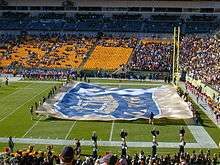
- A giant inflatable football helmet is set up on the lawn of the William Pitt Union during the week prior to football home games. Typically, information or other freebees are distributed around the helmet prior to the day of the game.[168]
- A 50-yard-long Hail to Pitt Flag is carried by 100 students, selected for each home football game, onto the field during pre-game ceremonies.[168]
- Student organizations, carrying standards, form a tunnel for the football players to run through as they enter the football field from the locker room. Originally, this long-standing tradition involved only Pitt fraternities and sororities. The tradition was briefly lost following the 1999 season when Pitt's football program transitioned from playing in Pitt Stadium to Three Rivers Stadium in 2000 followed by Heinz Field in 2001. The tradition was resurrected beginning with the 2008 football season.[169]
- Following touchdowns, the horns of the Gateway Clipper riverboat fleet, which cruises just outside Heinz Field, sound.
- When the Pitt offense moves into the 20-yard line, two large, motorized Heinz ketchup bottles flanking either side of the scoreboard tilt over and beginning to pour out their electronic contents onto the JumboTron's screen signifying the team's move into the "red zone".[168][170]
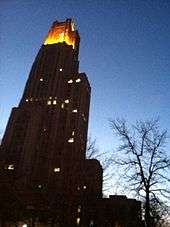
- The upper section of the Cathedral of Learning is illuminated gold with "victory lights" after a football team victory.[171]
- The jumbotron leads the crowd in a "Let's Go Pitt!" version of "Sweet Caroline" between the 3rd and 4th quarter.[172]
- Following home wins, the team gathers in front of the Pitt student section to celebrate with fans and the Pitt Band. After road wins, the team will also congregate near the Pitt visiting section to celebrate.
Student section
During the late 1990s, athletic director Steve Pederson instituted a rebranding of the Pitt Stadium student section in an attempt to bolster enthusiasm and unity by emphasizing the 12th man concept. The stadium was repainted with the student section changed to section "12" and a large inflatable jersey bearing number 12 was placed near the section. Upon the move to Heinz Field, the athletic department, in collaboration with their sideline apparel outfitter at the time Aéropostale, created the Aero-Zone. The Aero-Zone served as an exclusive on-field seating section for Pitt students where the first 200 students who lined up for the section before the game with student were admitted if they possessed tickets and proper identification.[173] The Aero-Zone failed to catch sustained interest and was eventually discontinued. Other groups also attempted to create a more unified student section for football.[174]
The current official Pitt football student fan club and cheering section, the Panther Pitt, was founded in 2003 by Pitt students Robin Frank and Julie Brennan to attempt to organize an Oakland Zoo-like atmosphere at Heinz Field for football games. The Panther Pitt helped in coordinating student ticking policies with the athletic department and the Oakland Zoo.[175][176] In 2006, the Panther Pitt and the Pitt Student Government Board originated the concept of "Code Blue" in which students wear blue T-shirts to the game to match the home blue uniforms of the Pitt football team.[177][178] During some seasons, these shirts were commonly worn by students attending football games with the back of "Code-Blue" T-shirts typically include the line "Alle-genee-genac-genac" from the Official University Yell. In 2013, ESPN recognized the Panther Pitt as one of the nation's best college football student sections.[179]
Rivalries
For most of Pitt's football history its chief rival had been in-state foe Penn State.[180] The first Pitt-Penn State game was played in 1893. The game has been played 97 times, with Penn State holding a 51–43–4 edge in the series. After a 16-year hiatus that occurred because of a well-documented refusal of Joe Paterno to resume the series[181] the rivalry was renewed following his death and resumed with a 42-39 Pitt victory on September 10, 2016.[86]
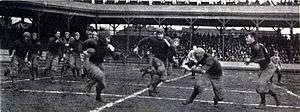
One of Pitt's fiercest rivals has been with the West Virginia Mountaineers. Dubbed the Backyard Brawl, the rivalry was first played in 1895 and is one of the oldest and most played in college football. Of historic note, the 1921 Backyard Brawl was the first live radio broadcast of a college football game in the United States. On November 10, 1979, the Backyard Brawl was the last college football game played at old Mountaineer Field in Morgantown, West Virginia, with the Panthers prevailing 24–17. Through the 2011 season, Pitt and West Virginia have met on the gridiron a total of 104 times with Pitt holding a 61–40–3 edge in the series. In September 2015 it was announced the series will renew for the 2022–2025 seasons.[182]
Other longstanding rivals include Notre Dame and Syracuse; both schools are tied as the third most played rivalry for Pitt. The series with Notre Dame began in 1909, and since that time no more than two consecutive seasons have passed without the teams meeting each other with the exception of the periods from 1913–1929, 1938–1942, and 1979–1981. Notre Dame currently leads the series 48–21–1. Games between Pitt and the Irish had typically been scheduled annually, however, Notre Dame's agreement to play five ACC opponents each year starting in 2014 precluded annual games, so Pitt and Notre Dame will meet no more than twice during a three-year period.[183] The rivalry with fellow ACC conference member Syracuse began in 1916, and has been played annually since 1955, with the Panthers leading the series 37–31–3. Pitt and Syracuse also shared membership in the Big East Conference from 1991 to 2012 before both schools simultaneously moved to the ACC where they are designated as cross-divisional rivals and are scheduled to meet annually.
Pitt and Navy recently renewed their rivalry, which began in 1912, and was played 26 times in 29 years between 1961 and 1989. Played consecutively between 2007 and 2009, and again in 2013, the series now stands with Pitt leading 22–14–3.[184] Of historic interest, it was during the Pitt-Navy game at Annapolis on October 23, 1976, that Pitt running back Tony Dorsett broke the NCAA career rushing record.
When the University of Cincinnati joined the Big East Conference in 2005, the game between Pitt and the Bearcats was designated as the River City Rivalry with the annual winner of the game being awarded the Paddlewheel Trophy. Each team won four games during the eight-year span that both schools shared membership in the Big East. Pitt leads the series 8–4. The series will be renewed in 2023 and 2024.[185]
Older rivalries against cross-town schools Duquesne and Carnegie Tech (now Carnegie Mellon University), as well as Washington & Jefferson, ended following the de-emphasizing of the football programs at those institutions.
Team awards and accomplishments
Undefeated seasons
.jpg)
Pitt has had eight undefeated seasons. Six of the eight seasons are perfect seasons with no ties. Of the eight undefeated seasons, four are not claimed as national championship seasons by Pitt. Pitt football finished the season undefeated in:
1904 (10–0) • 1910 (9–0) • 1915 (8–0) • 1916 (8–0) • 1917 (10–0) • 1920 (6–0–2) • 1937 (9–0–1) • 1976 (12–0)
One-loss seasons
Pitt also has had 17 one-loss seasons:
1894 • 1899 • 1914 • 1918 • 1925 • 1927 • 1929 • 1931 • 1932 • 1933 • 1934 • 1935 • 1936 • 1963 • 1979 • 1980 • 1981
Eastern and Conference titles
For much of its history, Pitt played as an independent, as did the majority of what are now labeled as Division I FBS football-playing schools located in the Northeast and Mid-Atlantic. During this time, Eastern Championships were named by independent third party selectors and awarded of various trophies, such as the early Jolly Trophy awarded by the Philadelphia-based Veteran Athletic Organization which presented it to the team with the best record in the East.[186] The process of picking an Eastern Champion eventually came to be symbolized by the Lambert-Meadowlands Trophy awarded by the New Jersey Sports and Exposition Authority beginning in 1936. The Lambert-Meadowlands trophy, which is still awarded, is presented to the team deemed to be the best that located in the East or plays half its schedule against eligible Lambert teams. In total, Pitt has won 12 Eastern Championships.[59]
In addition, in 1991, the majority of football independents in the East aligned themselves together in the Big East Football Conference. Round-robin play began in the Big East beginning in 1993, although a championship was awarded during its first two years.[187]
| ||||||||||||||||||||||||||||||||||||||||||||||||||||||||||||||||||||||||||||||||
Number 1 ranking
Pitt has achieved the number one ranking in the major national polls (AP since 1936 and Coaches' since 1950) on the following occasions:[188]
- 1982 (September 7, October 26, November 2)
- 1981 (November 3, 10, 17, 24)
- 1976 (November 9, 16, 23, 30, January 5, 1977#)
- 1939 (October 17)
- 1938 (October 18, 25, November 1)
- 1937 (November 9, 16, 23, 30#)
#National Champion
Individual awards
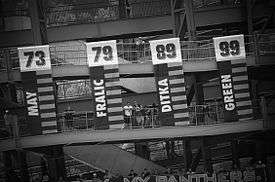
Retired numbers
Pitt has retired 10 jerseys of former football players.[189]
| No. | Player | Pos. | Career |
|---|---|---|---|
| 1 | Larry Fitzgerald | WR | 2002–03 |
| 13 | Dan Marino | QB | 1979–82 |
| 33 | Tony Dorsett | RB | 1973–76 |
| 42 | Marshall Goldberg | RB | 1936–38 |
| 65 | Joe Schmidt | LB | 1950–52 |
| 73 | Mark May | OT | 1977–80 |
| 75 | Jimbo Covert | OT | 1979–83 |
| 79 | Bill Fralic | OT | 1981–84 |
| 89 | Mike Ditka | E | 1958–60 |
| 99 | Hugh Green | DE | 1977–80 |
Major award winners
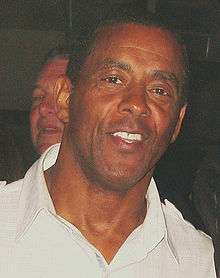
|
|
|
Heisman finalists
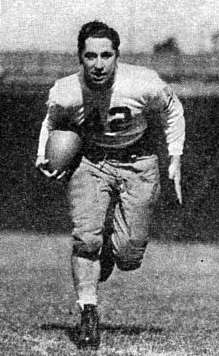
Pitt players were among the finalists for the Heisman Trophy Award in 14 different seasons.[190]
| Year | Name | Pos. | Finish |
|---|---|---|---|
| 1937 | Marshall Goldberg | RB | 3rd |
| 1938 | Marshall Goldberg | RB | 2nd |
| 1941 | Edgar Jones | RB | 7th |
| 1960 | Mike Ditka | E | 6th |
| 1975 | Tony Dorsett | RB | 4th |
| 1976 | Tony Dorsett | RB | 1st |
| 1977 | Matt Cavanaugh | QB | 7th |
| 1980 | Hugh Green | DE | 2nd |
| 1981 | Dan Marino | QB | 4th |
| 1982 | Dan Marino | QB | 9th |
| 1983 | Bill Fralic | T | 8th |
| 1984 | Bill Fralic | T | 6th |
| 1987 | Craig Heyward | RB | 5th |
| 2003 | Larry Fitzgerald | WR | 2nd |
College Football Hall of Fame inductees

25 total former players or coaches have been inducted into the College Football Hall of Fame.
Players
The College Football Hall of Fame has inducted 19 former Panthers inducted as players.
|
|
In addition, Herb McCracken, who played at Pitt from 1918–1920, was inducted as a coach of Allegheny and Lafayette.
Coaches
The College Football Hall of Fame has inducted four former Panther coaches.
- Jock Sutherland (Pitt player from 1914–1917, and Pitt coach from 1924–1938)
- Glenn "Pop" Warner (Pitt coach from 1915–1923)
- Clark Shaughnessy (Pitt coach from 1943–1945)
- Len Casanova (Pitt coach in 1950)
The following two Pitt coaches have been inducted into the Hall of Fame as players at their respective schools.
- Wes Fesler (Ohio State; Pitt coach in 1946)
- Johnny Majors (Tennessee; Pitt coach from 1973–1976 and 1993–1996)

First Team All-Americans
Pitt has had 76 different players selected as First Team All-American throughout its history for a total of 92 all-time First Team All-American Selections. That total includes 51 selections which have attained Consensus status. Pitt's Consensus First Team selections ranks as the twelfth most consensus All-Americans among Division I FBS schools.[7][191] The following list of Pitt's First Team All-Americans is compiled for the Pitt football media guide from various sources including the NCAA Football Guide, and consists of players who were first-team selections on one or more of the All American teams which were made over the years by Walter Camp, Grantland Rice, Caspar Whitney, International News Service, Associated Press, United Press International, NANA, NEA, the Football Writers Association of America, the Football Coaches Association, the All-America Board, Newsweek, The Sporting News, and Sports Illustrated.[192]
Academic All-Americans
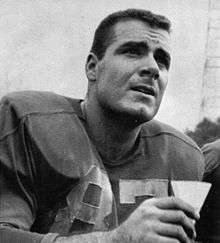
Pitt has had 15 different football players named as College Sports Information Directors of America Academic-All Americans for a total of 23 selections.[193] In addition, five Pitt players have been named as a National Scholar-Athletes by the National Football Foundation[194] and three players have awarded NCAA Postgraduate Scholarships.[191]
| Academic Honors | |||||||||||||||||||||||||||||||||||||||||||||||||||||||||||||||||||||||||||||||||||||||||
|---|---|---|---|---|---|---|---|---|---|---|---|---|---|---|---|---|---|---|---|---|---|---|---|---|---|---|---|---|---|---|---|---|---|---|---|---|---|---|---|---|---|---|---|---|---|---|---|---|---|---|---|---|---|---|---|---|---|---|---|---|---|---|---|---|---|---|---|---|---|---|---|---|---|---|---|---|---|---|---|---|---|---|---|---|---|---|---|---|---|
|
| ||||||||||||||||||||||||||||||||||||||||||||||||||||||||||||||||||||||||||||||||||||||||
| AA = Academic All-American; NCAA = NCAA Postgraduate Scholarship; NFF = National Football Foundation National Scholar-Athlete Ref:[191][193][194] *Listed as an Academic All-American in Pitt's Media Guide[194] but not by CoSIDA.[193] | |||||||||||||||||||||||||||||||||||||||||||||||||||||||||||||||||||||||||||||||||||||||||
Conference awards
The University of Pittsburgh football program was an independent for the majority of its history. It joined the Big East Conference for football in 1991, the inaugural year that the Big East sponsored the sport. Pitt won a share of the Big East football championship in 2004 and 2010. In 2013, Pitt joined the ACC. Several Panthers have won various Big East Conference football awards and Atlantic Coast Conference football awards, including Offensive Player, Defensive Player, Special Teams Player, Rookie, and Coach of the Year.
|
|
|
|
|
|
- *co-recipient, #unanimous selection
Panthers in the NFL
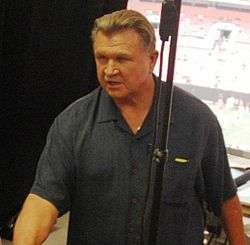
Pitt has produced 289 NFL players including eight that went on to be inducted into the Pro Football Hall of Fame[8] and 31 that have been selected to play in the Pro Bowl.[195] Furthermore, in a survey of NFL drafts from 1979 to 2009, ESPN rated Pitt third, behind only USC and Miami, for having "the most fertile NFL draft pipelines."[196] In addition, Pitt has been ranked second among all schools for the historical value of its drafted players.[197] Some former Pitt players that have left their mark on the NFL include Ruben Brown, Jim Covert, Mike Ditka, Chris Doleman, Tony Dorsett, Larry Fitzgerald, Russ Grimm, Craig "Ironhead" Heyward, Rickey Jackson, Dan Marino, Curtis Martin, Mark May, Darrelle Revis, Tony Siragusa, LeSean McCoy and Aaron Donald.
Pro Football Hall of Fame inductees
Eight Panthers have been elected into the Pro Football Hall of Fame. Pitt is tied for fourth among all colleges and universities for the number of former players inducted.[8] Pitt's eight Hall of Famers and their year of induction and years played are:
- Mike Ditka (Enshrined in 1988; Played 1957–1960)
- Chris Doleman (Enshrined in 2012; Played 1981–1984)
- Tony Dorsett (Enshrined in 1994; Played 1972–1976)
- Russ Grimm (Enshrined in 2010; Played 1977–1980)
- Rickey Jackson (Enshrined in 2010; Played 1977–1980)
- Dan Marino (Enshrined in 2005; Played 1979–1982)
- Curtis Martin (Enshrined in 2012; Played 1991–1994)
- Joe Schmidt (Enshrined in 1973; Played 1949–1952)
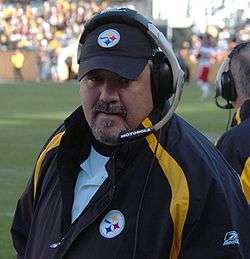
Pro Bowl selections

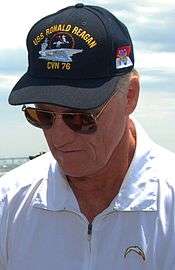
Through the 2017 NFL season, 32 former Pitt players have been selected to appear in the NFL Pro Bowl for a total of 120 all-time Pro Bowl selections. Pitt has been represented by at least one Pro Bowl selection every year since 1981.[195][198]
| Panthers selected for the Pro Bowl | ||||||||||||||||||||||||||||||||||||||||||||||||||||||||||||||||||||||||||||||||||||||||||||||||||||||||||||||||||||||||||||||||||||
|---|---|---|---|---|---|---|---|---|---|---|---|---|---|---|---|---|---|---|---|---|---|---|---|---|---|---|---|---|---|---|---|---|---|---|---|---|---|---|---|---|---|---|---|---|---|---|---|---|---|---|---|---|---|---|---|---|---|---|---|---|---|---|---|---|---|---|---|---|---|---|---|---|---|---|---|---|---|---|---|---|---|---|---|---|---|---|---|---|---|---|---|---|---|---|---|---|---|---|---|---|---|---|---|---|---|---|---|---|---|---|---|---|---|---|---|---|---|---|---|---|---|---|---|---|---|---|---|---|---|---|---|---|
|
NFL first round draftees
Throughout its history, the University of Pittsburgh has had 269 players selected 290 times in professional football drafts when totaling both NFL and AFL picks. This includes 25 First Round NFL draft picks since 1960.
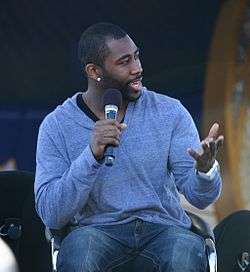
.jpg)
| Panthers Drafted in the NFL First Round | ||||||||||||||||||||||||||||||||||||||||||||||||||||||||||||||||||||||||||||||||||||||||||||||||||||||||||||||||||||||||||||||||||
|---|---|---|---|---|---|---|---|---|---|---|---|---|---|---|---|---|---|---|---|---|---|---|---|---|---|---|---|---|---|---|---|---|---|---|---|---|---|---|---|---|---|---|---|---|---|---|---|---|---|---|---|---|---|---|---|---|---|---|---|---|---|---|---|---|---|---|---|---|---|---|---|---|---|---|---|---|---|---|---|---|---|---|---|---|---|---|---|---|---|---|---|---|---|---|---|---|---|---|---|---|---|---|---|---|---|---|---|---|---|---|---|---|---|---|---|---|---|---|---|---|---|---|---|---|---|---|---|---|---|---|
|
Current NFL players
Currently there are 20 NFL players that played college football at the University of Pittsburgh:[199]
|
|
- #Selected to the Pro Bowl. &transferred to the University of Delaware for his final two seasons.
Season-by-season results
Pitt Panthers Football Recent Season-by-Season Info
| |||||||||||||||||||||||||||||||||||||||||||||||||||||||||||||||||||||||||||||||||||||||||||||||||||||||||||||||||||||||||||||||
|---|---|---|---|---|---|---|---|---|---|---|---|---|---|---|---|---|---|---|---|---|---|---|---|---|---|---|---|---|---|---|---|---|---|---|---|---|---|---|---|---|---|---|---|---|---|---|---|---|---|---|---|---|---|---|---|---|---|---|---|---|---|---|---|---|---|---|---|---|---|---|---|---|---|---|---|---|---|---|---|---|---|---|---|---|---|---|---|---|---|---|---|---|---|---|---|---|---|---|---|---|---|---|---|---|---|---|---|---|---|---|---|---|---|---|---|---|---|---|---|---|---|---|---|---|---|---|---|
Future non-conference opponents
Announced schedules as of January 2, 2018[200]
| 2019 | 2020 | 2021 | 2022 | 2023 | 2024 | 2025 |
| vs Delaware | vs Richmond | at Tennessee | vs Tennessee | vs Cincinnati | at Cincinnati | at West Virginia |
| vs Ohio | at Marshall | vs West Virginia | at West Virginia | vs West Virginia | vs Notre Dame | |
| at Penn State | vs Notre Dame | at Notre Dame | ||||
| vs UCF | vs Miami (OH) | |||||
See also
- List of Pittsburgh Panthers head football coaches
- List of Pittsburgh Panthers football All-Americans
- List of Pittsburgh Panthers football seasons, national championships and quarterbacks
Notes
- ↑ The University of Pittsburgh's football media guide does not list a 10–6 loss to Duquesne University for the 1903 season, although it appears in the Duquesne football media guide[15] and on College Football Data Warehouse. Therefore, the Pitt football media guide lists the record for the 1903 season as 0–8–1, and Mosse's overall record at the university as 20–10–1.[11] College Football Data Warehouse, whose numbers are used in this article, lists Mosse's 1903 record as 0–9–1, and his overall Pitt record as 20–11–1.[16]
- ↑ Various sources list the score of the 1904 Penn State win as 24–5, 23–5, and 22–5.[11][18] The score of 22–5 from the Courant,[19] a monthly student journal of the Western University of Pennsylvania, is identical to how the score is listed at College Football Data Warehouse,[20] and when used to calculate the total season points scored, matches the total listed above as reported in the book Pitt: The Story of the University of Pittsburgh 1787–1987: 406–5.[17]
- 1 2 The Official NCAA Records Book credits Washington & Jefferson as being the first documented college football team to use uniform numbers.[26]
- ↑ According to Sports Illustrated, Pitt was selected as a national champion in 1934 by Parke Davis,[44] or someone using his byline. Davis is deemed as a "major selector" of national champions according to the Official NCAA Records Book.[155] However, Davis' championship selection for 1934, reported by Sports Illustrated,[44] is missing from the Official NCAA Records Book, and thus Pitt is listed in the NCAA Records Book as having been named a national champion by a "major selector" in only 11, and not 12, seasons.
- 1 2 The total of 17 national championship season selections is arrived at by combining the 16 seasons listed by College Football Data Warehouse[30] plus the 1934 Parke Davis selection listed by Sports Illustrated and claimed by Pitt.[4][44]
- ↑ Based on a Sports Illustrated study conducted in 1970.[4]
- ↑ National Championships as listed in the Official NCAA Football Records Book as selected by "Major Selectors". The NCAA itself does not recognize or discriminate between national championship selections.[155]
- ↑ The University of Pittsburgh officially claims 9 national championships for the Panthers football team. The University of Pittsburgh bases its claim for the first 8 national championships on a study conducted in 1970 by Sports Illustrated. These championships, together with its unanimous championship of 1976, are the basis for the university's claim of 9 national championship seasons.[4]
References
- ↑ Borghetti, E.J.; Feeley, Ted; Welsh, Celeste; et al., eds. (July 19, 2014). 2014 Pitt Football Media Guide (PDF). University of Pittsburgh Athletic Media Relations Office. pp. 118–119. Retrieved May 17, 2015.
- ↑ "NCAA Football Award Winners" (PDF). National Collegiate Athletic Association. 2014. pp. 13–18. Retrieved December 19, 2014.
- ↑ "Licensing and Merchandising: Licensing at Pitt". Retrieved December 13, 2017.
- 1 2 3 4 5 6 7 8 9 Borghetti, E.J.; Nestor, Mendy; Welsh, Celeste, eds. (2008). 2008 Pitt Football Media Guide (PDF). University of Pittsburgh. p. 156. Retrieved 2010-07-07.
- ↑ "Division I-A All-Time Wins". College Football Data Warehouse. Archived from the original on 2009-01-22. Retrieved 2009-03-15.
- ↑ "National Football Foundation's College Football Hall of Fame: Hall of Famers,". Archived from the original on 2003-12-21. Retrieved 2009-03-15.
- 1 2 2012 NCAA Football Records Book (PDF). Indianapolis: National Collegiate Athletic Association. 2012. p. 18. Retrieved May 9, 2014.
- 1 2 3 "Hall of Famers by College". Pro Football Hall of Fame. Retrieved 2012-02-04.
- ↑ Sciullo Jr., Sam (2008). University of Pittsburgh Football Vault: The History of the Panthers. Atlanta: Whitman Publishing. p. 7. ISBN 0-7948-2653-9.
- ↑ Sciullo Jr., Sam (2008). University of Pittsburgh Football Vault: The History of the Panthers. Atlanta: Whitman Publishing, LLC. p. 8. ISBN 0-7948-2653-9.
- 1 2 3 4 Borghetti, E.J.; Nestor, Mendy; Welsh, Celeste, eds. (2008). 2008 Pitt Football Media Guide (PDF). University of Pittsburgh. p. 148. Retrieved 2009-04-08.
- ↑ Starrett, Agnes Lynch (1937). Through one hundred and fifty years: the University of Pittsburgh. University of Pittsburgh Press. p. 355.
- ↑ Sciullo Jr., Sam (2008). University of Pittsburgh Football Vault: The History of the Panthers. Atlanta: Whitman Publishing. p. 9. ISBN 0-7948-2653-9.
- ↑ Sciullo Jr., Sam (2008). University of Pittsburgh Football Vault: The History of the Panthers. Atlanta: Whitman Publishing. p. 12. ISBN 0-7948-2653-9.
- ↑ Duquesne Football 2008 Media Guide (PDF). 2008. p. 45. Retrieved 2009-02-18.
- ↑ "Coaching Records Game by Game: Arthur St. L. "Texas" Mosse: 1903". College Football Data Warehouse. Retrieved 2009-02-18.
- 1 2 Alberts, Robert C. (1986). Pitt: The Story of the University of Pittsburgh 1787–1987. University of Pittsburgh Press. p. 65. ISBN 0-8229-1150-7. Retrieved 2009-02-18.
- ↑ The Owl. Junior Class of the Western University of Pennsylvania. 1907. p. 261. Retrieved 2010-06-02.
- ↑ "School News". Courant. Western University of Pennsylvania. 20 (3): 21. December 1904. Retrieved 2009-02-19.
- ↑ "Coaching Records Game by Game: 1904". College Football Data Warehouse. Retrieved 2009-02-18.
- ↑ Sciullo Jr., Sam (2008). University of Pittsburgh Football Vault: The History of the Panthers. Atlanta: Whitman Publishing. p. 13. ISBN 0-7948-2653-9.
- ↑ Sam Sciullo; Sam Sciullo, Jr. (2004). Tales from the Pitt Panthers. Sports Publishing LLC. ISBN 1-58261-198-X.
- 1 2 O'Brien, Jim (editor) (1982). Hail to Pitt: A Sports History of the University of Pittsburgh. Wolfson Publishing Co. p. 62. ISBN 0-916114-08-2.
- 1 2 Sullivan, George (2004). Any Number Can Play: The Numbers Athletes Wear. Millbrook Press. p. 13. ISBN 0-7613-1557-8.
- 1 2 Murphy, Arthur (1959-09-28). "Memo From The Publisher". Sports Illustrated: 15. Archived from the original on 2012-12-06.
- ↑ "College Football Rules Changes – Equipment" (PDF). Football Bowl Subdivision Records. National Collegiate Athletic Association. 2009. p. 130. Archived from the original (PDF) on 2010-06-02. Retrieved 2010-06-02.
- ↑ The Owl. University of Pittsburgh. 1911. Retrieved 2009-03-31.
- ↑ "Yearly National Championship Selections". www.cfbdatawarehouse.com.
- ↑ Sciullo Jr., Sam (2008). University of Pittsburgh Football Vault: The History of the Panthers. Atlanta: Whitman Publishing. p. 25. ISBN 0-7948-2653-9.
- 1 2 3 4 5 6 7 8 9 College Football Data Warehouse: Pittsburgh All National Championships: Pittsburgh Total National Championships, accessdate=2009-04-08 Archived 2008-07-04 at the Wayback Machine.
- ↑ "Yearly National Championship Selections". www.cfbdatawarehouse.com. Archived from the original on 2012-11-14.
- ↑ Sciullo Jr., Sam (2008). University of Pittsburgh Football Vault: The History of the Panthers. Atlanta: Whitman Publishing. pp. 28–29. ISBN 0-7948-2653-9.
- ↑ "Robert W. Richards Pneumonia Victim", Eagle, November 8, 1918.
- ↑ Keck, Harry (November 30, 1918). "Navy Reserves Steal Game From Pitt". Pittsburgh Sunday Post. Nashville, Tennessee: Athlon Sports Communications: 33. ISBN 1-878839-04-7 – via The Greatest Moments in Pitt Football History (1994).
- ↑ Sciullo Jr., Sam (2008). University of Pittsburgh Football Vault: The History of the Panthers. Atlanta: Whitman Publishing. p. 36. ISBN 0-7948-2653-9.
- ↑ "College Football Data Warehouse: Yearly National Championship Selections: 1918 National Champions". Retrieved 2009-04-08.
- 1 2 Sciullo Jr, Sam, ed. (1991). 1991 Pitt Football: University of Pittsburgh Football Media Guide. University of Pittsburgh Sports Information Office. p. 116.
- ↑ Sack, Jack : Jews In Sports @ Virtual Museum
- ↑ Past Division I-A Football National Champions Archived 2006-08-26 at the Wayback Machine.
- ↑ "Pitt Pittsburgh – PittsburghPanthers.com – Official Athletic Site of the University of Pittsburgh". www.cstv.com.
- ↑ Sciullo Jr., Sam (2008). University of Pittsburgh Football Vault: The History of the Panthers. Atlanta: Whitman Publishing. p. 41. ISBN 0-7948-2653-9.
- ↑ Sciullo Jr., Sam (2008). University of Pittsburgh Football Vault: The History of the Panthers. Atlanta: Whitman Publishing. p. 47. ISBN 0-7948-2653-9.
- ↑ Daley, Arthur J. (October 20, 1934). "Minnesota Trickery Dooms Panthers". The New York Times. Nashville, Tennessee: Athlon Sports Communications: 42. ISBN 1-878839-04-7 – via The Greatest Moments in Pitt Football History, 1994.
- 1 2 3 4 5 6 Jenkins, Dan (September 11, 1967). "This Year The Fight Will Be In The Open". Sports Illustrated. Chicago. 27 (11): 30–33. Retrieved 2016-02-08.
- ↑ "Alabama Football 2003" (PDF). Tuscaloosa, Alabama: University of Alabama. 2003: 248–249. Archived from the original (PDF) on 2012-07-14. Retrieved 2009-04-08.
- ↑ "College Football Data Warehouse: Yearly National Championship Selections: 1936 National Champions". Archived from the original on 2010-02-11. Retrieved 2009-04-08.
- ↑ Beachler, Eddie (1982). "Panthers Became National Power on Single Wing During Torrid '30s". In O'Brien, Jim. Hail to Pitt: A Sports History of the University of Pittsburgh. Pittsburgh: Wolfson Publishing Co. p. 59. ISBN 0-916114-08-2.
- ↑ Devold, Harry (September 29, 1987). ""Dream Backfield" put Pitt in National Spotlight". The Football News, republished in the Greatest Moments in Pitt Football History (1994). Nashville, Tennessee: Athlon Sports Communications: 59. ISBN 1-878839-04-7.
- ↑ Sciullo Jr., Sam (2004). Tales From the Pitt Panthers. Champaign, Illinois: Sports Publishing LLC. p. 59. ISBN 1-58261-198-X. Retrieved 2009-04-10.
- ↑ "College Football Data Warehouse: Yearly National Championship Selections: 1937 National Champions". Retrieved 2009-04-08.
- ↑ Sciullo Jr., Sam (2008). University of Pittsburgh Football Vault: The History of the Panthers. Atlanta: Whitman Publishing. p. 49. ISBN 0-7948-2653-9.
- ↑ Wallace, Francis (October 28, 1939). "Test Case at Pitt". The Saturday Evening Post, republished in the Greatest Moments in Pitt Football History (1994). Nashville, Tennessee: Athlon Sports Communications: 61. ISBN 1-878839-04-7.
- ↑ Alberts, Robert C. (1986). Pitt: The Story of the University of Pittsburgh 1787–1987. University of Pittsburgh Press. p. 165. ISBN 0-8229-1150-7. Retrieved 2008-08-26.
- ↑ Sciullo Jr., Sam (2008). University of Pittsburgh Football Vault: The History of the Panthers. Atlanta: Whitman Publishing. p. 55. ISBN 0-7948-2653-9.
- ↑ Daley, Arthur (October 29, 1938). "Pitt Finally Defeats Fordham". The New York Times. Nashville, Tennessee: Athlon Sports Communications: 55. ISBN 1-878839-04-7 – via The Greatest Moments in Pitt Football History (1994).
- ↑ Wallace, Francis (November 24, 1939). "The Football Factory Explodes". The Saturday Evening Post, republished in the Greatest Moments in Pitt Football History (1994). Nashville, Tennessee: Athlon Sports Communications: 73. ISBN 1-878839-04-7.
- ↑ Alberts, Robert C. (1986). Pitt: The Story of the University of Pittsburgh 1787–1987. University of Pittsburgh Press. p. 167. ISBN 0-8229-1150-7. Retrieved 2008-08-26.
- ↑ Alberts, Robert C. (1986). Pitt: The Story of the University of Pittsburgh 1787–1987. University of Pittsburgh Press. p. 158. ISBN 0-8229-1150-7. Retrieved 2008-08-26.
- 1 2 3 University of Pittsburgh 1975 football media guide. University of Pittsburgh. 1975. p. 54. Retrieved 2008-08-26.
- ↑ Wallace, William N. (1994-10-15). "COLLEGE FOOTBALL; This Pitt Backfield Is Still a Dream". The New York Times. Retrieved 2008-08-26.
- 1 2 2007 Pitt Football Media Guide (PDF). p. 176. Retrieved 2008-08-26.
- ↑ Sciullo Jr., Sam (2004). Tales from the Pitt Panthers. Champaign, Illinois: Sports Publishing L.L.C. pp. 9–10. ISBN 1-58261-198-X. Retrieved 2009-09-13.
- ↑ "Conference May Demand New Entry". Pittsburgh Post-Gazette. 1939-12-25. Retrieved 2009-12-15.
- ↑ Byers, Walter; Hammer, Charles (1997). Unsportsmanlike Conduct: Exploiting College Athletes. University of Michigan Press. p. 44. ISBN 0-472-08442-9. Retrieved 2009-12-15.
- ↑ Eldridge, Jr., Larry; Venzon, Linda, eds. (1989). 1989 Pitt Football University of Pittsburgh Football Media Guide. University of Pittsburgh. p. 92.
- 1 2 Thamel, Pete (2006-01-01). "Grier Integrated a Game and Earned the World's Respect". New York Times. Retrieved 2009-04-15.
- ↑ University of Pittsburgh football media guide 2002, pg. 213, accessdate=2009-01-29
- ↑ Gorman, Kevin (2008-10-30). "Pitt-Notre Dame series produces phenomenal performances". Pittsburgh Tribune-Review. Archived from the original on 2013-01-04. Retrieved 2010-04-29.
- ↑ Associated Press (1976-10-24). "Tony Dorsett No. 1". Reading Eagle. p. 77. Retrieved 2010-05-01.
- ↑ Mackin, Mike (2008-06-12). "Let's Learn From the Past: The 1976 Pitt Panthers". Pittsburgh Post-Gazette. Retrieved 2010-04-29.
- ↑ "Yearly National Championship Selections: 1976 national championships". College Football Data Warehouse. Archived from the original on 2007-11-09. Retrieved 2009-04-15.
- ↑ Fitzgerald, Francis J., ed. (1996). The Year the Panthers Roared. Louisville, Kentucky: AdCraft Sports. ISBN 1-887761-06-3.
- ↑ Sciullo Jr., Sam (2004). Tales From the Pitt Panthers. Champaign, Illinois: Sports Publishing LLC. pp. 110–111. ISBN 1-58261-198-X. Retrieved 2009-04-10.
- ↑ Sciullo Jr., Sam (2004). Tales From the Pitt Panthers. Champaign, Illinois: Sports Publishing LLC. pp. 37–39. ISBN 1-58261-198-X. Retrieved 2009-04-10.
- ↑ Smizik, Bob (2000-11-02). "Smizik: 1980 Panthers rank among best". Pittsburgh Post-Gazette. Retrieved 2009-04-15.
- ↑ Starkey, Joe (2008-02-03). "Incomplete: Four great Pittsburgh teams that did not win it all". Pittsburgh Tribune-Review. Retrieved 2009-04-15.
- ↑ Jr, GORDON S. WHITE (29 September 1982). "TEXAS A&M SIGNS SHERRILL TO RICHEST COLLEGE PACT" – via select.nytimes.com.
- ↑ Zeise, Paul (2008-12-06). "No. 9 has special meaning for Panthers". Pittsburgh Post-Gazette. Retrieved 2009-04-15.
- ↑ Gottfried, Mike; Benson, Ron (2007). Coach's Challenge: Faith, Football, and Filling the Father Gap. New York: Simon and Schuster. pp. 197–198. ISBN 1-4165-4355-4. Retrieved 2009-04-10.
- ↑ Robinson, Alan (1989-12-19). "Pitt brass tells why Gottfried was fired". Associated Press.
- ↑ University of Pittsburgh football media guide 2002, pg. 269, accessdate=2009-01-29
- ↑ Anderson, Shelly (2007-06-12). "Johnny Majors returning to his home again – in Tennessee". Pittsburgh Post-Gazette. Retrieved 2009-04-15.
- ↑ "Mike Prisuta, Pederson Man behind turning of the Panthers' athletic fortunes, Pittsburgh Tribune-Review, 2002-04-07". Retrieved 2009-01-29.
- ↑ Gorman, Kevin (2007-12-01). "Pederson returns at Pitt AD". Pittsburgh Tribune-Review. Archived from the original on 2007-12-02. Retrieved 2012-04-28.
- ↑ "Pitt gets it right with Pederson's return".
- 1 2 Fittipaldo, Ray (2011-06-14). "Pitt, Penn State to renew football rivalry in 2016". Pittsburgh Post-Gazette. Retrieved 2011-06-14.
- ↑ Cook, Ron (2008-09-28). "Harris not bitter over days at Pitt". Pittsburgh Post-Gazette. Retrieved 2009-04-15.
- ↑ Zeise, Paul (2005-04-15). "Pittsburgh is gone, Pitt back as Panthers unveil different football uniforms, logo". Pittsburgh Post-Gazette. Retrieved 2009-04-15.
- ↑ "Football Recruiting: Team Rankings 2006". Scout.com. 2006-02-28. Retrieved 2010-01-13.
- ↑ "Football Recruiting: Team Rankings 2007". Scout.com. 2007-02-28. Retrieved 2010-01-13.
- ↑ "Pitt throws curveball at BCS with win over No. 2 WVU". Morgantown, West Virginia. Associated Press. 2007-12-01. Retrieved 2009-04-15.
- ↑ Associated Press (2010-12-07). "Dave Wannstedt resigns at Pitt". ESPN.com. Retrieved 2010-12-16.
- 1 2 "Pittsburgh hires Haywood as new head coach". ESPN.com. 16 December 2010.
- ↑ "Pitt fires coach facing domestic violence charge". ESPN.com. 1 January 2011.
- ↑ "Over and Out! Shortest Coaching Tenures – George O'Leary: Notre Dame". Daily News. New York.
- ↑ Gorman, Kevin (2011-01-03). "Wannstedt will not coach Pitt in Compass Bowl". Pittsburgh Tribune-Review. Archived from the original on 2011-01-06. Retrieved 2011-01-03.
- ↑ Zeise, Paul; Brink, Bill (2010-01-11). "Pitt's search ends with hiring of Tulsa's Graham". Pittsburgh Post-Gazette. Retrieved 2010-01-11.
- ↑ "New coach Graham: Pitt fans 'won't want to sit'". ESPN.com. 11 January 2011.
- ↑ Glicksman, Ben (2011-05-10). "New coach Graham working to remake Pitt on and off the field". SI.com. Retrieved 2011-08-19.
- ↑ Fittipaldo, Ray (July 18, 2012). "Pitt's move to the Atlantic Coast Conference is now official". Pittsburgh Post-Gazette. Retrieved July 18, 2012.
- ↑ "Todd Graham to coach Sun Devils". ESPN.com. 2011-12-14. Retrieved 2011-12-14.
- ↑ "Keith Patterson Named Interim Coach for Pitt Football". PittsburghPanthers.com. 2011-12-14. Retrieved 2011-12-14.
- ↑ "SMU vs. Pittsburgh - Game Recap - January 7, 2012 - ESPN". ESPN.com.
- 1 2 "Pitt turns to Wisconsin's Chryst to be new coach".
- ↑ Zeise, Paul (2011-12-23). "Pitt's new football coach Chryst prefers doing to talking". Pittsburgh Post-Gazette. Retrieved 2011-12-28.
- ↑ Werner, Sam (2013-12-27). "Pitt beats Bowling Green, 30–27, in Little Caesars Pizza Bowl". Pittsburgh Post-Gazette. Retrieved 2011-12-27.
- ↑ Armas, Genaro C. "Wisconsin brings Pitt's Chryst home as coach". Yahoo! News. Retrieved December 18, 2014.
- ↑ "Shake-up at University of Pittsburgh athletics: AD Pederson fired as Chryst leaves".
- ↑ http://www.espn.com/college-football/story/_/id/12082492/pat-narduzzi-officially-takes-pittsburgh-panthers-head-coach
- ↑ http://bleacherreport.com/articles/2109144-the-15-best-defensive-coordinators-in-college-football
- ↑ http://triblive.com/sports/college/pitt/9604827-74/pitt-narduzzi-barnes
- ↑ https://www.sports-reference.com/cfb/schools/pittsburgh/2015-schedule.html
- ↑ http://www.espn.com/college-football/recap?gameId=400756902
- ↑ http://www.espn.com/college-football/recap?gameId=400756915
- ↑ http://www.espn.com/college-football/recap?gameId=400756926
- ↑ http://www.espn.com/college-football/recap?gameId=400756945
- ↑ http://www.espn.com/college-football/recap?gameId=400756951
- ↑ http://www.espn.com/college-football/recap?gameId=400756955
- ↑ http://www.espn.com/college-football/recap?gameId=400756965
- ↑ http://www.espn.com/college-football/recap?gameId=400756966
- ↑ http://www.espn.com/college-football/recap?gameId=400756978
- ↑ http://www.espn.com/college-football/recap?gameId=400756981
- ↑ http://www.espn.com/college-football/recap?gameId=400756991
- ↑ http://www.espn.com/college-football/recap?gameId=400756994
- ↑ http://www.espn.com/college-football/recap?gameId=400852721
- ↑ "Pittsburgh". 247Sports. Retrieved 2016-11-18.
- ↑ http://www.post-gazette.com/sports/Pitt/2015/12/10/Pitt-Panthers-coach-Pat-Narduzzi-signs-two-year-contract-extension/stories/201512100138
- ↑ https://www.sports-reference.com/cfb/schools/pittsburgh/2016-schedule.html
- ↑ http://www.espn.com/college-football/recap?gameId=400869426
- ↑ http://www.espn.com/college-football/recap?gameId=400869436
- ↑ http://www.espn.com/college-football/recap?gameId=400869442
- ↑ http://www.espn.com/college-football/recap?gameId=400869449
- ↑ http://www.espn.com/college-football/recap?gameId=400869373
- ↑ http://www.espn.com/college-football/recap?gameId=400869458
- ↑ http://www.espn.com/college-football/recap?gameId=400869465
- ↑ http://www.espn.com/college-football/recap?gameId=400869471
- ↑ http://www.espn.com/college-football/recap?gameId=400869481
- ↑ http://www.espn.com/college-football/recap?gameId=400869485
- ↑ http://www.espn.com/college-football/recap?gameId=400869492
- ↑ http://www.espn.com/college-football/recap?gameId=400869500
- ↑ http://www.espn.com/college-football/recap?gameId=400876097
- ↑ https://www.sports-reference.com/cfb/schools/pittsburgh/2017-schedule.html
- ↑ http://www.espn.com/college-football/recap?gameId=400937450
- ↑ http://www.espn.com/college-football/recap?gameId=400935245
- ↑ http://www.espn.com/college-football/recap?gameId=400934509
- ↑ http://www.espn.com/college-football/recap?gameId=400937486
- ↑ http://www.espn.com/college-football/recap?gameId=400937491
- ↑ http://www.espn.com/college-football/recap?gameId=400937497
- ↑ http://www.espn.com/college-football/recap?gameId=400937499
- ↑ http://www.espn.com/college-football/recap?gameId=400937509
- ↑ http://www.espn.com/college-football/recap?gameId=400937514
- ↑ http://www.espn.com/college-football/recap?gameId=400937528
- ↑ http://www.espn.com/college-football/recap?gameId=400937529
- ↑ http://www.espn.com/college-football/story/_/id/21689741/pittsburgh-panthers-sign-pat-narduzzi-7-year-contract
- 1 2 Official 2009 NCAA Division I Football Records Book (PDF). Indianapolis: The National Collegiate Athletic Association. August 2009. pp. 76–77. Retrieved 2009-10-16.
- ↑ "2008 NCAA Division I Records Book, pgs. 76–81" (PDF). Retrieved 2009-01-08.
- ↑ 2012 NCAA Football Bowl Subdivision Records (PDF). Indianapolis: The National Collegiate Athletic Association. August 2012. pp. 71–73. Retrieved 2012-12-28.
- 1 2 "Pittsburgh Composite Championship Listing: Recognized National Championships". College Football Data Warehouse. Retrieved August 11, 2016.
- ↑ Pedersen, Paul M.; Parks, Janet B.; Quarterman, Jerome; Thibault, Lucie, eds. (2011). Contemporary Sport Management (4th ed.). Champaign, Illinois: Human Kinetics. p. 50. ISBN 978-0-7360-8167-2. Retrieved 2012-03-25.
- ↑ Official 2008 NCAA Division I Football Records Book (PDF). Indianapolis: The National Collegiate Athletic Association. August 2008. pp. 195–196. ISSN 0735-5475. Retrieved 2009-08-19.
- ↑ "Hall of Famers: Hugh Green". National Football Foundation & College Hall of Fame. Archived from the original on 2012-07-22. Retrieved 2009-09-04.
- ↑ Humes, Michael (August 20, 2013). ""By the Numbers": Three-Part Look at College Football on ESPN Networks – Part 1" (Press release). ESPN MediaZone. Retrieved August 26, 2013.
- ↑ Zeise, Paul (2003-12-12). "Double Win For Fitzgerald". Pittsburgh Post-Gazette. Retrieved 2011-11-29.
- ↑ "Alumni Traditions: Rub the Panther's Nose". Pitt Alumni Association. 2010-06-23. Retrieved 2011-11-29.
- ↑ 2012 Hyundai Tucson: "Nose Rub" (Television commercial). HyundaiUSA. September 30, 2011. Retrieved 2012-04-28.
- 1 2 2008 Panther Football Fan Guide, pg. 2, ISP Sports; accessdate=2008-08-24
- 1 2 "Pitt Traditions Part of Debut Season at New Heinz Field; Pitt Campaign Chronicle; August 20/27, 2001". Retrieved 2008-08-24.
- 1 2 3 "Pitt Traditions". Pitt Alumni Association. 2010-06-23. Retrieved 2011-11-29.
- ↑ Upcoming events: Pitt Students – Make Your Heinz Field Standard / Claim Your Grill Night (August 27), Pittsburghpanthers.com; accessdate 2008-08-24
- ↑ "Giant Heinz Ketchup Bottles Make Their NFL Debut During Steelers-Titans Game; Monday Night Football Shines at Heinz Field". Business Wire. 2001-10-29. Retrieved 2011-11-29.
- ↑ Bennett, Brian (2010). "Big East game-day traditions: Pittsburgh". ESPN. Retrieved 2010-03-04.
- ↑ Gibb, Emily (2010-11-26). "'Sweet Caroline' boosts Brawl". Pittsburgh Post-Gazette. Retrieved 2010-11-26.
- ↑ Masny, Daniel (2001-08-29). "Coach Harris calls on the 12th man". The Pitt News. Retrieved 2008-04-20.
- ↑ "Cat Basket". thecatbasket.blogspot.com.
- ↑ "Student Organization Resource Center: Panther Pitt". University of Pittsburgh Office of Student Life. 2008-03-06. Retrieved 2008-04-19.
- ↑ Schwab, Nikki (2003-10-24). "Panther Pitt colors games blue and gold with towels". The Pitt News. Retrieved 2011-11-29.
- ↑ "Thomas, Dave; Panthers face must-win game against Mountaineers; Pitt News, November 15, 2006". Retrieved 2008-08-25.
- ↑ "EDITORIAL – Priestas best choice for SGB president, The Pitt News, November 7, 2007". Retrieved 2008-08-25.
- ↑ "Best Student Sections in College Football: Pittsburgh". ESPN.com. August 15, 2013. Retrieved August 13, 2013.
- ↑ Paths of Glory: The Dramatic Story of Pitt's First Century of Football (video). Wetterau Corporation and Ross Sports Productions. 1990. Retrieved April 29, 2017.
- ↑ Shetler, Matt. "Pitt Panthers Football: Is It Finally Time To Renew the Penn State Rivalry?".
- ↑ "Pitt, West Virginia Renew Backyard Brawl for 2022-2025". 10 September 2015.
- ↑ Keller, Mathew (2005-05-28). "Notre Dame, Big East agree to series of football games". Pittsburgh Tribune-Review. Archived from the original on 2008-06-09. Retrieved 2010-01-13.
- ↑ "Pitt Future Non-Conference Football Schedules". PittsburghPanthers.com. Retrieved 2010-01-13.
- ↑ "Pitt, Cincinnati schedule 2023-24 footballs series". 17 June 2015.
- ↑ The Owl (1929), University of Pittsburgh, 1929, pg. 125
- ↑ Sullivan, Chuck, ed. (2008). Big East Conference 2008 Football Media Guide (PDF). Providence, Rhode Island: Big East Conference. p. 133. Retrieved 2009-03-17.
- ↑ Sullivan, Chuck, ed. (2008). Big East Conference 2008 Football Media Guide (PDF). Providence, Rhode Island: Big East Conference. p. 188. Retrieved 2009-03-17.
- ↑ "Larry Fitzgerald Joins Legendary List of Pitt Retired Jerseys". PittsburghPanthers.com. July 1, 2013. Retrieved July 1, 2013.
- ↑ "Heisman Trophy: Heisman Winners". Heisman.com. Archived from the original on 2014-08-01. Retrieved 2012-02-06.
- 1 2 3 Sullivan, Chuck, ed. (2008). Big East Conference 2008 Football Media Guide (PDF). Providence, Rhode Island: Big East Conference. p. 168. Retrieved 2009-03-17.
- 1 2 Borghetti, E.J.; Nestor, Mendy; Welsh, Celeste, eds. (2008). 2008 Pitt Football Media Guide (PDF). University of Pittsburgh. p. 158.
- 1 2 3 CoSIDA Academic All-American All-Time List (by School) (PDF), College Sports Information Directors of America, 2012-03-08, pp. 352–353, retrieved 2012-06-02
- 1 2 3 4 Borghetti, E.J.; Nestor, Mendy; Welsh, Celeste, eds. (2008). 2008 Pitt Football Media Guide (PDF). University of Pittsburgh. p. 164.
- 1 2 "Pittsburgh Players/Alumni". Pro-Football-Reference.com. Retrieved 2010-08-09.
- ↑ Schlabach, Mark (2010-05-10). "SEC not alone in elite NFL talent". ESPN.com. Retrieved 2010-05-12.
- ↑ Tuccitto, Danny (April 16, 2013). "Historical Draft Efficiency: College Rankings". Football Outsiders. Retrieved May 30, 2013.
- ↑ Nestor, Mendy; Borghetti, E.J.; Welsh, Celeste, eds. (2010). 2010 Pitt Football Media Guide (PDF). University of Pittsburgh. p. 194. Retrieved 2010-08-08.
- ↑ Nestor, Mendy; Borghetti, E.J.; Welsh, Celeste, eds. (2010). 2010 Pitt Football Media Guide (PDF). University of Pittsburgh. p. 186. Retrieved 2010-08-08.
- ↑ "Pitt Panthers Football Schedules and Future Schedules". fbschedules.com. Retrieved May 22, 2017.
Further information
- University of Pittsburgh Football Vault: The History of the Panthers. Sam Sciullo, Jr. Atlanta: Whitman Pulblishing, 2008, ISBN 0-7948-2653-9
- University of Pittsburgh Football Media Guide 2008. E.J. Borghetti, Mendy Nestor, and Celeste Welsch eds. Pittsburgh: University of Pittsburgh, 2008
- Paths of Glory: The Dramatic Story of Pitt's First Century of Football. Video. Ross Sports Productions. 1991
- Greatest Moments in Pitt Football History. Mike Bynum, Larry Eldridge, Jr., and Sam Sciullo, Jr. eds. Nashville, Tennessee: Athlon Sports Communications, 1994, ISBN 1-878839-04-7
- Hail to Pitt: A Sports History of the University of Pittsburgh. Jim O'Brien, ed. and Marty Wolfson, illus. Pittsburgh; Wolfson Publishing Co., 1982, ISBN 978-0916114084
- Pitt: The Story of the University of Pittsburgh 1787–1987. Robert C. Alberts. Pittsburgh, Pennsylvania: University of Pittsburgh Press, 1986, ISBN 0-8229-1150-7
- Sciullo, Jr., Sam (2000). Pitt Stadium Memories 1925–1999. University of Pittsburgh. ASIN B0006RFHJQ.
- Tales from the Pitt Panthers. Sam Sciullo, Jr. Champaign, Illinois: Sports Publishing LLC, 2004, ISBN 1-58261-198-X
- The Year the Panthers Roared. Francis J. Fitzgerald, ed., Louisville, Kentucky, AdCraft Sports, 1996, ISBN 1-887761-06-3
- Jock Sutherland: Architect of Men. Harry G. Scott. New York: Exposition Press, 1954.

